Signed in as:
filler@godaddy.com
Signed in as:
filler@godaddy.com

Many of the rules in the Code are legal requirements, and if you disobey these rules you are committing a criminal offence. You may be fined, given penalty points on your licence or be disqualified from driving. In the most serious cases you may be sent to prison. Such rules are identified by the use of the word
Many of the rules in the Code are legal requirements, and if you disobey these rules you are committing a criminal offence. You may be fined, given penalty points on your licence or be disqualified from driving. In the most serious cases you may be sent to prison. Such rules are identified by the use of the words ‘MUST/MUST NOT’. In addition, the rule includes an abbreviated reference to the legislation which creates the offence. See an explanation of the abbreviations.
Although failure to comply with the other rules of the Code will not, in itself, cause a person to be prosecuted, The Highway Code may be used in evidence in any court proceedings under the Traffic Acts (see The road user and the law) to establish liability. This includes rules which use advisory wording such as ‘should/should not’ or ‘do/do not’.
Knowing and applying the rules contained in The Highway Code could significantly reduce road casualties. Cutting the number of deaths and injuries that occur on our roads every day is a responsibility we all share. The Highway Code can help us discharge that responsibility. Further information on driving/riding techniques can be found in ‘The Official DVSA Guide to Driving - the essential skills’ and ‘The Official DVSA Guide to Riding - the essential skills’.
The ‘hierarchy of road users’ is a concept that places those road users most at risk in the event of a collision at the top of the hierarchy. The hierarchy does not remove the need for everyone to behave responsibly. The road users most likely to be injured in the event of a collision are pedestrians, cyclists, horse riders and motorcyclists, with children, older adults and disabled people being more at risk. The following H rules clarify this concept.
Rule H1
It is important that ALL road users are aware of The Highway Code, are considerate to other road users and understand their responsibility for the safety of others.
Everyone suffers when road collisions occur, whether they are physically injured or not. But those in charge of vehicles that can cause the greatest harm in the event of a collision bear the greatest responsibility to take care and reduce the danger they pose to others. This principle applies most strongly to drivers of large goods and passenger vehicles, vans/minibuses, cars/taxis and motorcycles.
Cyclists, horse riders and drivers of horse drawn vehicles likewise have a responsibility to reduce danger to pedestrians.
None of this detracts from the responsibility of ALL road users, including pedestrians, cyclists and horse riders, to have regard for their own and other road users’ safety.
Always remember that the people you encounter may have impaired sight, hearing or mobility and that this may not be obvious.
Rule H2 - Rule for drivers, motorcyclists, horse drawn vehicles, horse riders and cyclists
At a junction you should give way to pedestrians crossing or waiting to cross a road into which or from which you are turning.
You MUST give way to pedestrians on a zebra crossing, and to pedestrians and cyclists on a parallel crossing (see Rule 195).
Pedestrians have priority when on a zebra crossing, on a parallel crossing or at light controlled crossings when they have a green signal.
You should give way to pedestrians waiting to cross a zebra crossing, and to pedestrians and cyclists waiting to cross a parallel crossing.
Horse riders should also give way to pedestrians on a zebra crossing, and to pedestrians and cyclists on a parallel crossing.
Cyclists should give way to pedestrians on shared use cycle tracks and to horse riders on bridleways.
Only pedestrians may use the pavement. Pedestrians include wheelchair and mobility scooter users.
Pedestrians may use any part of the road and use cycle tracks as well as the pavement, unless there are signs prohibiting pedestrians.
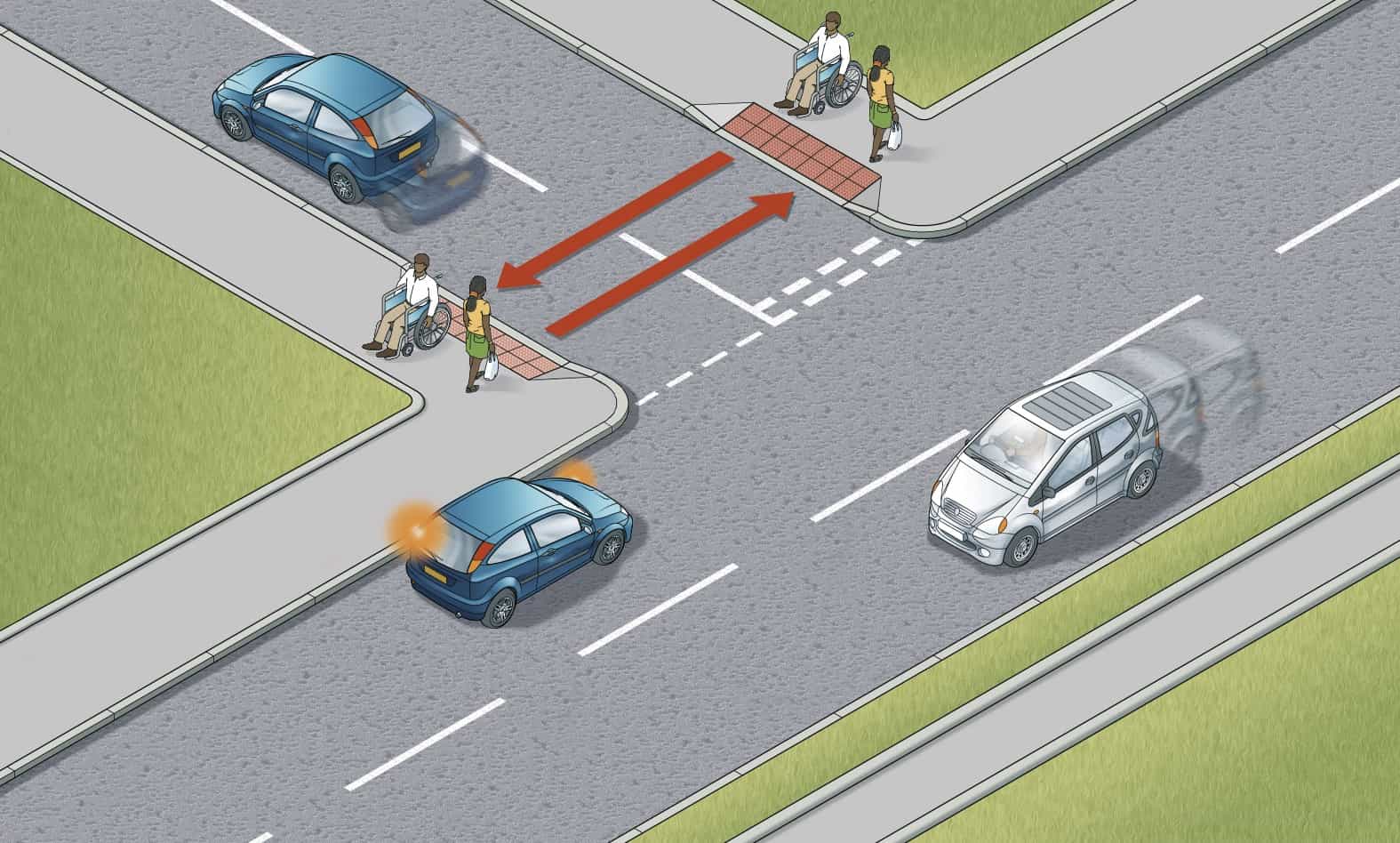
Rule H2: Wait for the pedestrian to cross the junction before turning. This applies if you are turning right or left into the junction.
Laws TSRGD Schedule 14 part 1 and part 5 & HA 1835 sect 72, R(S)A 1984, sect 129 & Countryside Act 1968 Sect 1 part 30
Rule H3 - Rule for drivers and motorcyclists
You should not cut across cyclists, horse riders or horse drawn vehicles going ahead when you are turning into or out of a junction or changing direction or lane, just as you would not turn across the path of another motor vehicle. This applies whether they are using a cycle lane, a cycle track, or riding ahead on the road and you should give way to them.
Do not turn at a junction if to do so would cause the cyclist, horse rider or horse drawn vehicle going straight ahead to stop or swerve.
You should stop and wait for a safe gap in the flow of cyclists if necessary. This includes when cyclists are:
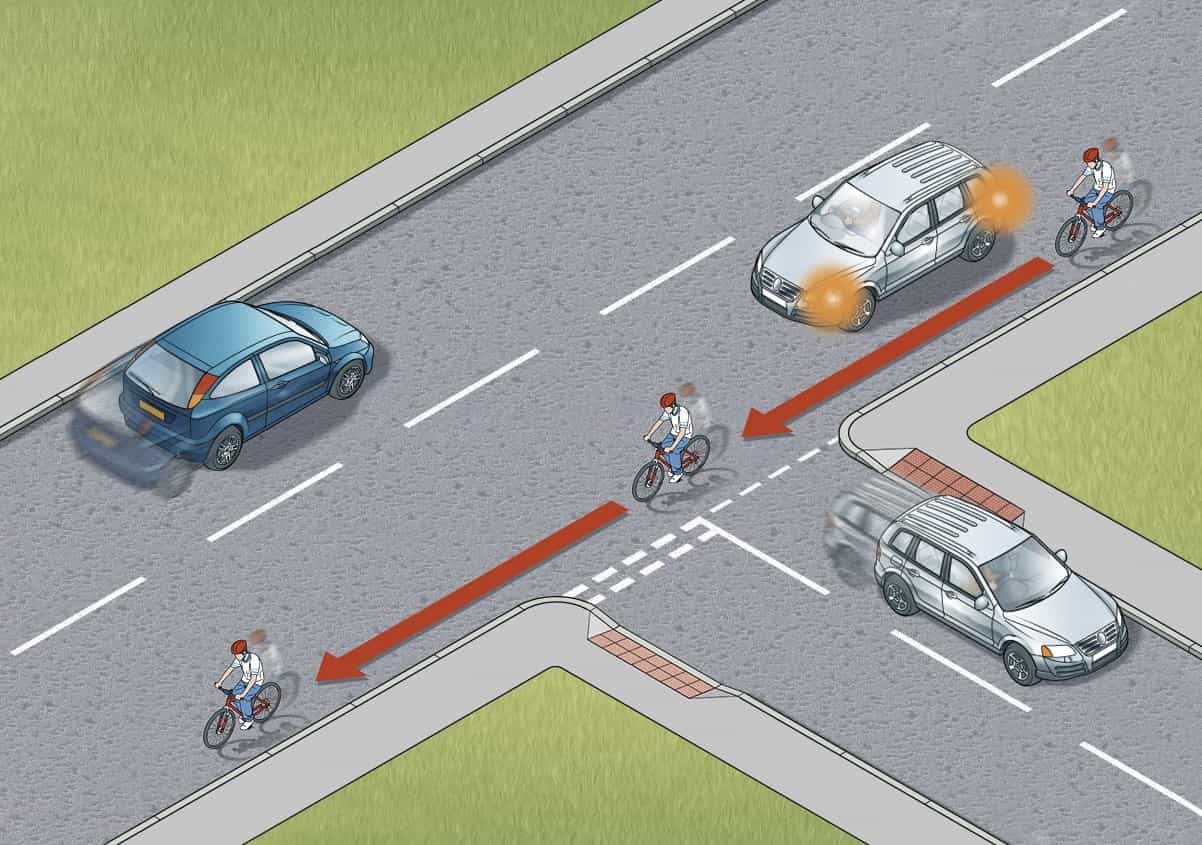
Rule H3: Wait for the cyclist to pass the junction before turning. This also applies if there is a cycle lane or cycle track and if you are turning right or left into the junction.

Rule 1
Pavements and footways (including any path along the side of a road) should be used if provided. Where possible, avoid being next to the kerb with your back to the traffic. If you have to step into the road, look both ways first. Always remain aware of your environment and avoid unnecessary distraction
Rule 1
Pavements and footways (including any path along the side of a road) should be used if provided. Where possible, avoid being next to the kerb with your back to the traffic. If you have to step into the road, look both ways first. Always remain aware of your environment and avoid unnecessary distractions. Always show due care and consideration for others.
Rule 2
If there is no pavement, keep to the right-hand side of the road so that you can see oncoming traffic. You should take extra care and
It may be safer to cross the road well before a sharp right-hand bend so that oncoming traffic has a better chance of seeing you. Cross back after the bend.
Rule 3
Help other road users to see you. Wear or carry something light-coloured, bright or fluorescent in poor daylight conditions. When it is dark, use reflective materials (eg armbands, sashes, waistcoats, jackets, footwear), which can be seen by drivers using headlights up to three times as far away as non-reflective materials.
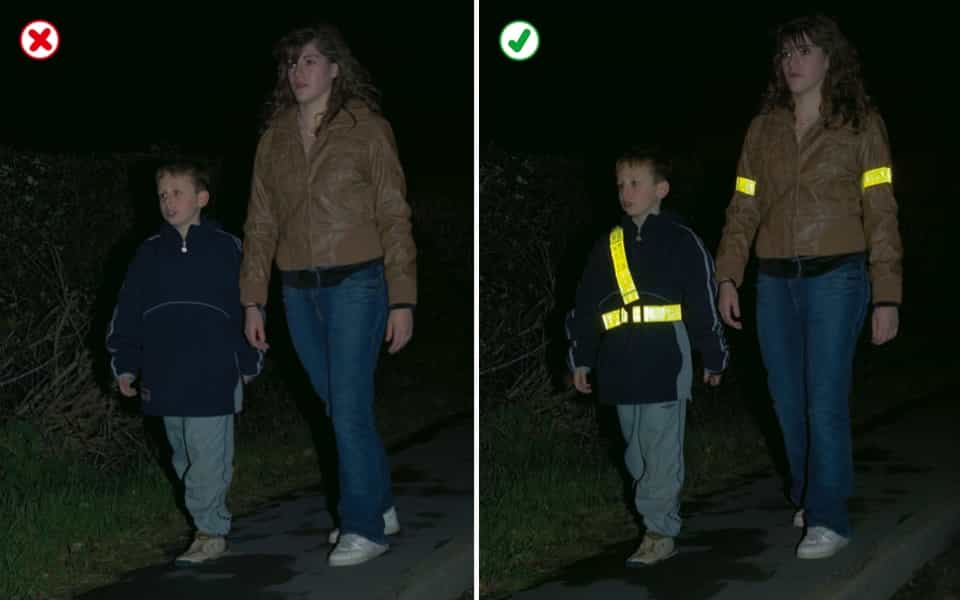
Rule 3: Help yourself to be seen
Rule 4
Young children should not be out alone on the pavement or road (see Rule 7). When taking children out, keep between them and the traffic and hold their hands firmly. Strap very young children into pushchairs or use reins. When pushing a young child in a buggy, do not push the buggy into the road when checking to see if it is clear to cross, particularly from between parked vehicles.
Rule 5
Organised walks or parades involving large groups of people walking along a road should use a pavement if available; if one is not available, they should keep to the left. Look-outs should be positioned at the front and back of the group, and they should wear fluorescent clothes in daylight and reflective clothes in the dark. At night, the look-out in front should show a white light and the one at the back a red light. People on the outside of large groups should also carry lights and wear reflective clothing.
Rule 6
Motorways. Pedestrians MUST NOT be on motorways or slip roads except in an emergency (see Rules 272 and 277).
Laws RTRA sect 17, MT(E&W)R reg 15(1)(b) & MT(S)R reg 13
Rule 7
The Green Cross Code. The advice given below on crossing the road is for all pedestrians. Children should be taught the Code and should not be allowed out alone until they can understand and use it properly. The age when they can do this is different for each child. Many children cannot judge how fast vehicles are going or how far away they are. Children learn by example, so parents and carers should always use the Code in full when out with their children. They are responsible for deciding at what age children can use it safely by themselves.
A First find a safe place to cross and where there is space to reach the pavement on the other side. Where there is a crossing nearby, use it. It is safer to cross using a subway, a footbridge, an island, a zebra, pelican, toucan or puffin crossing, or where there is a crossing point controlled by a police officer, a school crossing patrol or a traffic warden. Otherwise choose a place where you can see clearly in all directions. Try to avoid crossing between parked cars (see Rule 14), on a blind bend, or close to the brow of a hill. Move to a space where drivers and riders can see you clearly. Do not cross the road diagonally.
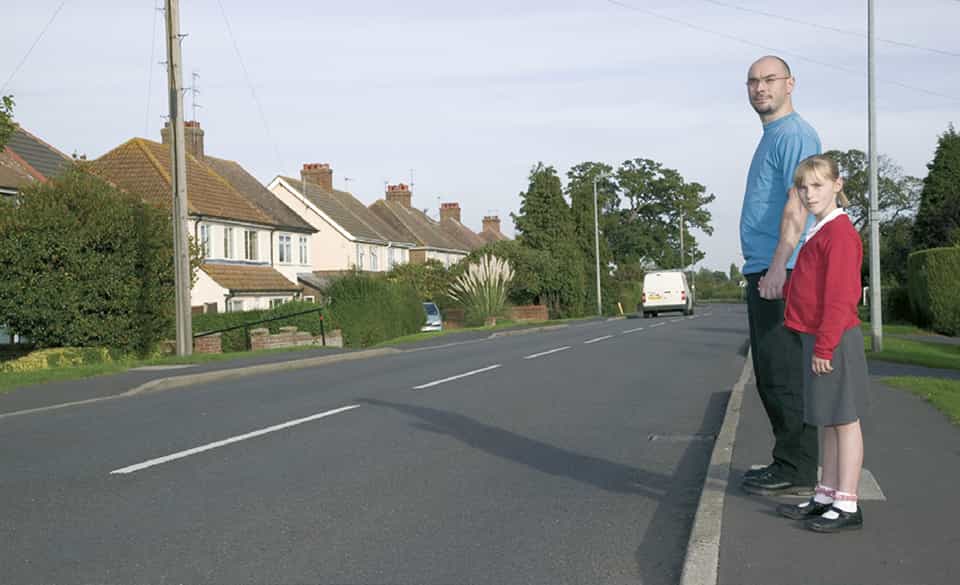
Rule 7: Look all around and listen for traffic before crossing
B Stop just before you get to the kerb, where you can see if anything is coming. Do not get too close to the traffic. If there’s no pavement, keep back from the edge of the road but make sure you can still see approaching traffic.
C Look all around for traffic and listen. Traffic could come from any direction. Listen as well, because you can sometimes hear traffic before you see it.
D If traffic is coming, let it pass. Look all around again and listen. Do not cross until there is a safe gap in the traffic and you are certain that there is plenty of time. Remember, even if traffic is a long way off, it may be approaching very quickly.
E When it is safe, go straight across the road – do not run. Keep looking and listening for traffic while you cross, in case there is any traffic you did not see, or in case other traffic appears suddenly. Look out for cyclists and motorcyclists travelling between lanes of traffic. Do not walk diagonally across the road.
Rule 8
At a junction. When you are crossing or waiting to cross the road, other traffic should give way. Look out for traffic turning into the road, especially from behind you, and cross at a place where drivers can see you. If you have started crossing and traffic wants to turn into the road, you have priority and they should give way (see Rules H2 and 170).
Rule 9
Pedestrian Safety Barriers. Where there are barriers, cross the road only at the gaps provided for pedestrians. Do not climb over the barriers or walk between them and the road.
Rule 10
Tactile paving. Raised surfaces that can be felt underfoot provide warning and guidance to blind or partially sighted people. The most common surfaces are a series of raised studs, which are used at crossing points with a dropped kerb, or a series of rounded raised bars which are used at level crossings, at the top and bottom of steps and at some other hazards.
Rule 11
One-way streets. Check which way the traffic is moving. Do not cross until it is safe to do so without stopping. Bus and cycle lanes may operate in the opposite direction to the rest of the traffic.
Rule 12
Bus and cycle lanes. Take care when crossing these lanes as traffic may be moving faster than in the other lanes, or against the flow of traffic.
Rule 13
Routes shared with cyclists. Cycle tracks may run alongside footpaths or pavements and be separated from them by a feature such as a change of material, a verge, a kerb or a white line. Such routes may also incorporate short lengths of tactile paving to help visually impaired people stay on the correct side. On the pedestrian side this may comprise a series of flat-topped bars running across the direction of travel (ladder pattern). On the cyclist side the same bars are orientated in the direction of travel (tramline pattern).
Some routes shared with cyclists will not be separated by such a feature allowing cyclists and pedestrians to share the same space. Cyclists should respect your safety (see Rule 62) but you should also take care not to obstruct or endanger them. Always remain aware of your environment and avoid unnecessary distractions.
Where signs indicate, some routes are shared between pedestrians, cyclists, horse riders and horse drawn vehicles. Cyclists, horse riders and drivers of horse drawn vehicles should respect your safety, but you should take care not to obstruct or endanger them. Always remain aware of your environment and avoid unnecessary distractions.
Rule 14
Parked vehicles. If you have to cross between parked vehicles, use the outside edges of the vehicles as if they were the kerb. Stop there and make sure you can see all around and that the traffic can see you. Make sure there is a gap between any parked vehicles on the other side, so you can reach the pavement. Never cross the road in front of, or behind, any vehicle with its engine running, especially a large vehicle, as the driver may not be able to see you.
Rule 15
Reversing vehicles. Never cross behind a vehicle which is reversing, showing white reversing lights or sounding a warning.
Rule 16
Moving vehicles. You MUST NOT get onto or hold onto a moving vehicle.
Law RTA 1988 sect 26
Rule 17
At night. Wear something reflective to make it easier for others to see you (see Rule 3). If there is no pedestrian crossing nearby, cross the road near a street light so that traffic can see you more easily.
Rule 18
At all crossings. When using any type of crossing you should
You MUST NOT loiter on any type of crossing.
Laws TSRGD Schedule 14 part 5 and RTRA sect 25(5)
Rule 19
Zebra crossings. Give traffic plenty of time to see you and to stop before you start to cross. Vehicles will need more time when the road is slippery. Wait until traffic has stopped from both directions or the road is clear before crossing. Remember that traffic does not have to stop until someone has moved onto the crossing. Drivers and riders should give way to pedestrians waiting to cross and MUST give way to pedestrians on a zebra crossing (see Rule H2). Keep looking both ways, and listening, in case a driver or rider has not seen you and attempts to overtake a vehicle that has stopped.
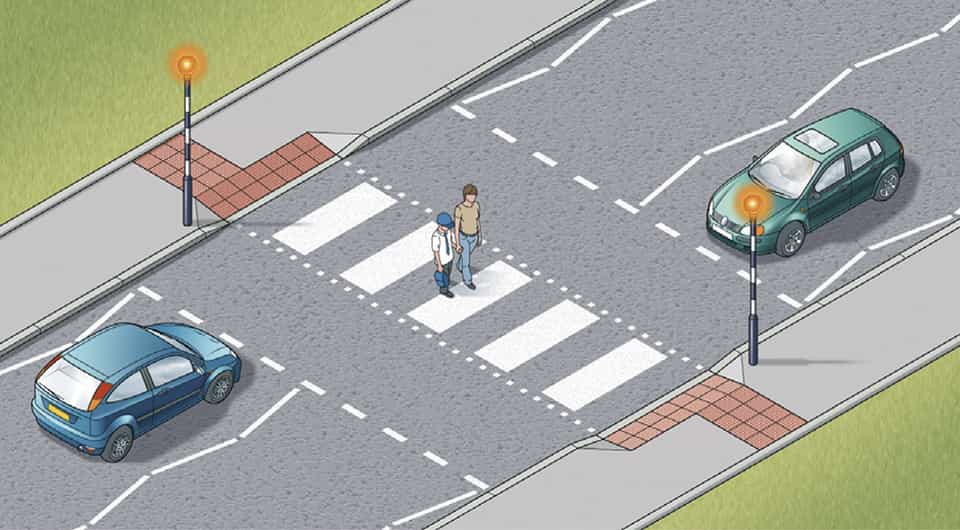
Rule 19: Zebra crossings have flashing beacons
A zebra crossing with a central island is two separate crossings (see Rule 20).
Law TSRGD Schedule 14 part 5
Rule 20
Where there is an island in the middle of a zebra crossing, wait on the island and follow Rule 19 before you cross the second half of the road - it is a separate crossing.
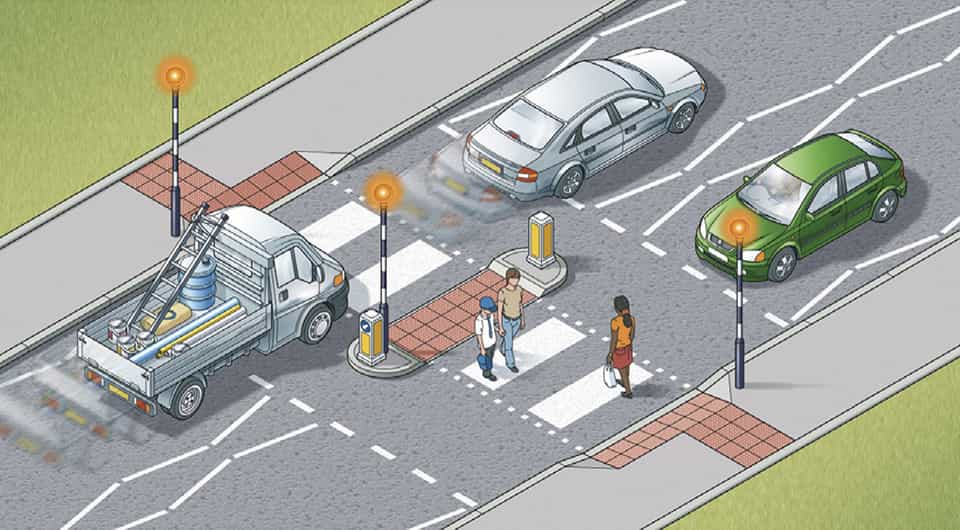
Rule 20: Zebra crossings with a central island are two separate crossings
Rule 21
At traffic lights. There may be special signals for pedestrians. You should only start to cross the road when the green figure shows. If you have started to cross the road and the green figure goes out, you should still have time to reach the other side, but do not delay. If no pedestrian signals have been provided, watch carefully and do not cross until the traffic lights are red and the traffic has stopped. Keep looking and check for traffic that may be turning the corner. Remember that traffic lights may let traffic move in some lanes while traffic in other lanes has stopped.
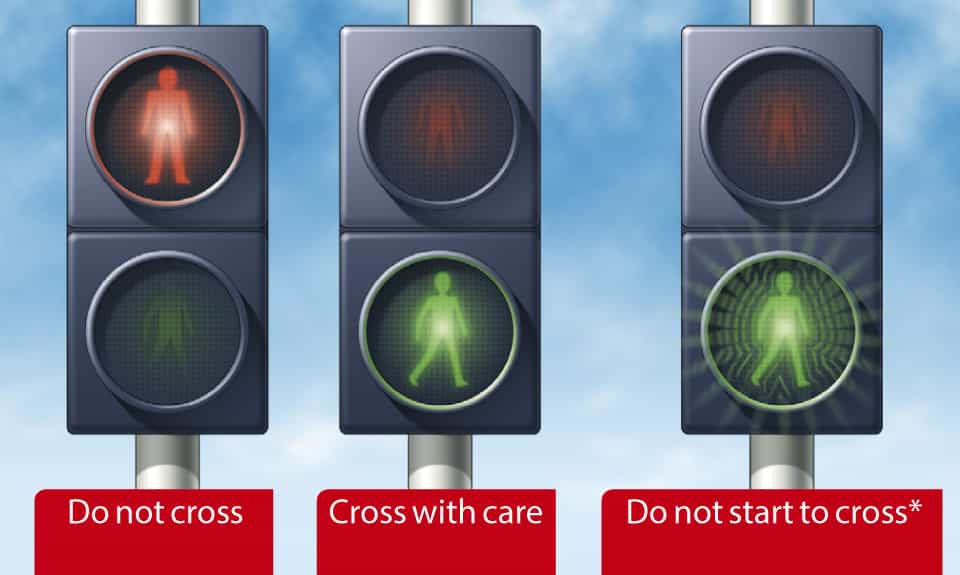
Rule 21: At traffic lights, puffin and pelican crossings. *At pelican crossings only.
Rule 22
Pelican crossings. These are signal-controlled crossings operated by pedestrians. Push the control button to activate the traffic signals. When the red figure shows, do not cross. When a steady green figure shows, check the traffic has stopped then cross with care. When the green figure begins to flash you should not start to cross. If you have already started you should have time to finish crossing safely.
Rule 23
Puffin crossings differ from pelican crossings as the red and green figures are above the control box on your side of the road and there is no flashing green figure phase. Press the button and wait for the green figure to show.
Rule 24
When the road is congested, traffic on your side of the road may be forced to stop even though their lights are green. Traffic may still be moving on the other side of the road, so press the button and wait for the signal to cross.
Rule 25
Toucan crossings are light-controlled crossings which allow cyclists and pedestrians to share crossing space and cross at the same time. They are push-button operated. Pedestrians and cyclists will see the green signal together. Cyclists are permitted to ride across.
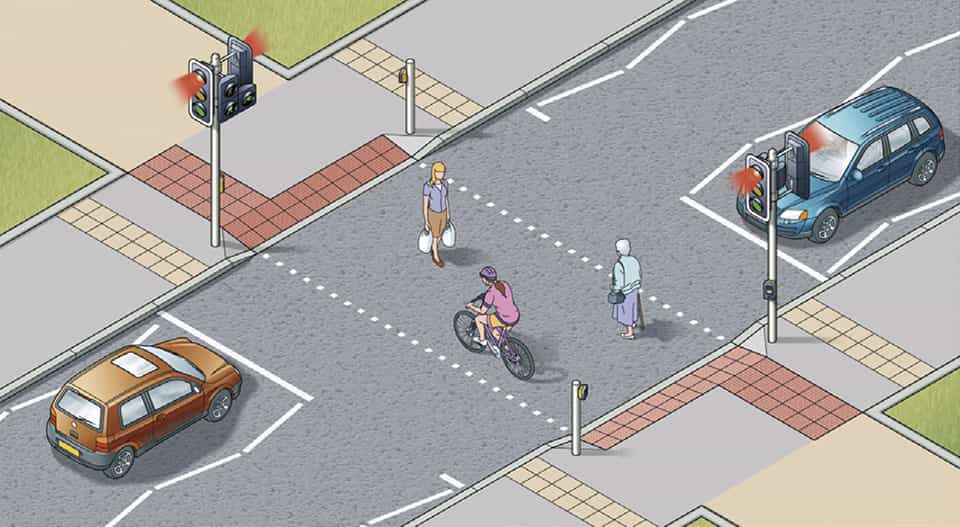
Rule 25: Toucan crossings can be used by both cyclists and pedestrians
Rule 26
At some crossings there is a bleeping sound or voice signal to indicate to blind or partially sighted people when the steady green figure is showing, and there may be a tactile signal to help deafblind people.
Rule 27
Equestrian crossings are for horse riders. They have pavement barriers, wider crossing spaces, horse and rider figures in the light panels and either two sets of controls (one higher), or just one higher control panel.
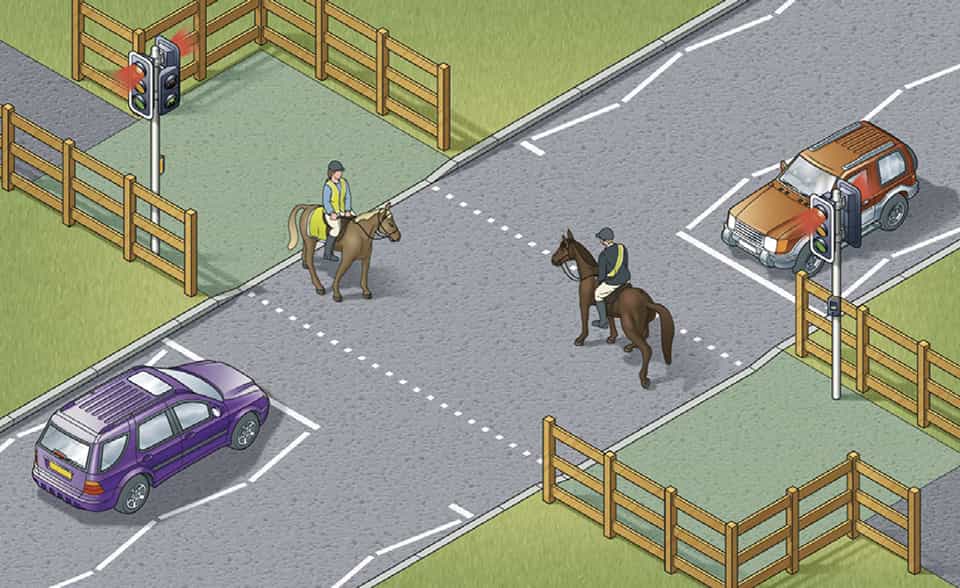
Rule 27: Equestrian crossings are used by horse riders. There is often a parallel crossing
Rule 28
Staggered’ pelican or puffin crossings. When the crossings on each side of the central refuge are not in line they are two separate crossings. On reaching the central island, press the button again and wait for a steady green figure.
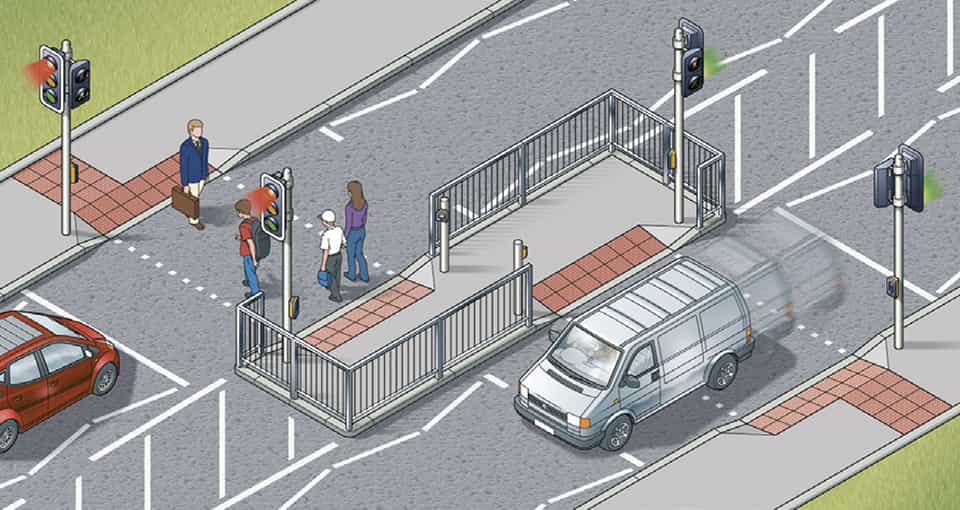
Rule 28: Staggered crossings (with an island in the middle) are two separate crossings
Rule 29
Crossings controlled by an authorised person. Do not cross the road unless you are signalled to do so by a police officer, traffic warden or school crossing patrol. Always cross in front of them.
Rule 30
Where there are no controlled crossing points available it is advisable to cross where there is an island in the middle of the road. Use the Green Cross Code (see Rule 7) to cross to the island and then stop and use it again to cross the second half of the road.
Rule 31
Emergency vehicles. If an ambulance, fire engine, police or other emergency vehicle approaches using flashing blue lights, headlights and/or sirens, keep off the road.
Rule 32
Buses. Get on or off a bus only when it has stopped to allow you to do so. Watch out for cyclists when you are getting off. Never cross the road directly behind or in front of a bus. Wait until it has moved off and you can see clearly in both directions.
Rule 33
Tramways. These may run through pedestrian areas. Their path will be marked out by shallow kerbs, changes in the paving or other road surface, white lines or yellow dots. Cross at designated crossings where provided. Elsewhere treat trams as you would other road vehicles and look both ways along the track before crossing. Do not walk along the track as trams may come up behind you. Trams move quietly and cannot steer to avoid you.
Rule 34
Railway level crossings. You MUST NOT cross or pass a stop line when the red lights show, (including a red pedestrian figure). Also do not cross if an alarm is sounding or the barriers are being lowered. The tone of the alarm may change if another train is approaching. If there are no lights, alarms or barriers, stop, look both ways and listen before crossing. A tactile surface comprising rounded bars running across the direction of pedestrian travel may be installed on the footpath approaching a level crossing to warn visually impaired people of its presence. The tactile surface should extend across the full width of the footway and should be located at an appropriate distance from the barrier or projected line of the barrier.
Law TSRGD schedule 14 part 1
Rule 35
Street and pavement repairs. A pavement may be closed temporarily because it is not safe to use. Take extra care if you are directed to walk in or to cross the road.

Rule 36
There is one class of manual wheelchair (called a Class 1 invalid carriage) and two classes of powered wheelchairs and powered mobility scooters. Manual wheelchairs and Class 2 vehicles are those with an upper speed limit of 4 mph (6 km/h) and are designed to be used on pave
Rule 36
There is one class of manual wheelchair (called a Class 1 invalid carriage) and two classes of powered wheelchairs and powered mobility scooters. Manual wheelchairs and Class 2 vehicles are those with an upper speed limit of 4 mph (6 km/h) and are designed to be used on pavements. Class 3 vehicles are those with an upper speed limit of 8 mph (12 km/h) and are equipped to be used on the road as well as the pavement.
Rule 37
When you are on the road you should obey the guidance and rules for other vehicles; when on the pavement you should follow the guidance and rules for pedestrians.
Rule 38
Pavements are safer than roads and should be used when available. You should give pedestrians priority and show consideration for other pavement users, particularly those with a hearing or visual impairment who may not be aware that you are there.
Rule 39
Powered wheelchairs and scooters MUST NOT travel faster than 4 mph (6 km/h) on pavements or in pedestrian areas. You may need to reduce your speed to adjust to other pavement users who may not be able to move out of your way quickly enough or where the pavement is too narrow.
Law UICHR reg 4
Rule 40
When moving off the pavement onto the road, you should take special care. Before moving off, always look round and make sure it’s safe to join the traffic. Always try to use dropped kerbs when moving off the pavement, even if this means travelling further to locate one. If you have to climb or descend a kerb, always approach it at right angles and don’t try to negotiate a kerb higher than the vehicle manufacturer’s recommendations.
Rule 41
You should take care when travelling on the road as you may be travelling more slowly than other traffic (your machine is restricted to 8 mph (12 km/h) and may be less visible).
Rule 42
When on the road, Class 3 vehicles should travel in the direction of the traffic. Class 2 users should always use the pavement when it is available. When there is no pavement, you should use caution when on the road. Class 2 users should, where possible, travel in the direction of the traffic. If you are travelling at night when lights MUST be used, you should travel in the direction of the traffic to avoid confusing other road users.
Law UICHR reg 9
Rule 43
You MUST follow the same rules about using lights, indicators and horns as for other road vehicles, if your vehicle is fitted with them. At night, lights MUST be used. Be aware that other road users may not see you and you should make yourself more visible - even in the daytime and also at dusk - by, for instance, wearing a reflective jacket or reflective strips on the back of the vehicle.
Law UICHR reg 9
Rule 44
Take extra care at road junctions. When going straight ahead, check to make sure there are no vehicles about to cross your path from the left, the right, or overtaking you and turning left. There are several options for dealing with right turns, especially turning from a major road. If moving into the middle of the road is difficult or dangerous, you can
If the junction is too hazardous, it may be worth considering an alternative route. Similarly, when negotiating major roundabouts (i.e. with two or more lanes) it may be safer for you to use the pavement or find a route which avoids the roundabout altogether.
Rule 45
All normal parking restrictions should be observed. Your vehicle should not be left unattended if it causes an obstruction to other pedestrians - especially those in wheelchairs. Parking concessions provided under the Blue Badge scheme (see Further reading) will apply to those vehicles displaying a valid badge.
Rule 46
These vehicles MUST NOT be used on motorways (see Rule 253). They should not be used on unrestricted dual carriageways where the speed limit exceeds 50 mph (80 km/h) but if they are used on these dual carriageways, they MUST have a flashing amber beacon. A flashing amber beacon should be used on all other dual carriageways (see Rule 220).
Laws RTRA sects 17(2) & (3), & RVLR regs 17(1) & 26.

Rule 47
Horse-drawn vehicles used on the highway should be operated and maintained in accordance with standards set out in the Department for Transport’s Code of Practice for Horse-Drawn Vehicles. This Code lays down the requirements for a road driving assessment and includes a comprehensive list of saf
Rule 47
Horse-drawn vehicles used on the highway should be operated and maintained in accordance with standards set out in the Department for Transport’s Code of Practice for Horse-Drawn Vehicles. This Code lays down the requirements for a road driving assessment and includes a comprehensive list of safety checks to ensure that a carriage and its fittings are safe and in good working order. The standards set out in the Road Driving Assessment may be required to be met by a Local Authority if an operator wishes to obtain a local authority licence to operate a passenger-carrying service.
Rule 48
Safety equipment and clothing. All horse-drawn vehicles should have two red rear reflectors. It is safer not to drive at night but if you do, a light showing white to the front and red to the rear MUST be fitted.
Law RVLR reg 4
Rule 49
Safety equipment. Children under the age of 14 MUST wear a helmet which complies with the Regulations. It MUST be fastened securely. Other riders should also follow these requirements. These requirements do not apply to a child who is a follower of the Sikh religion while wearing a turban.
Laws H(PHYR)A sect 1 & H(PHYR)R reg 3
Rule 50
Other clothing. You should wear
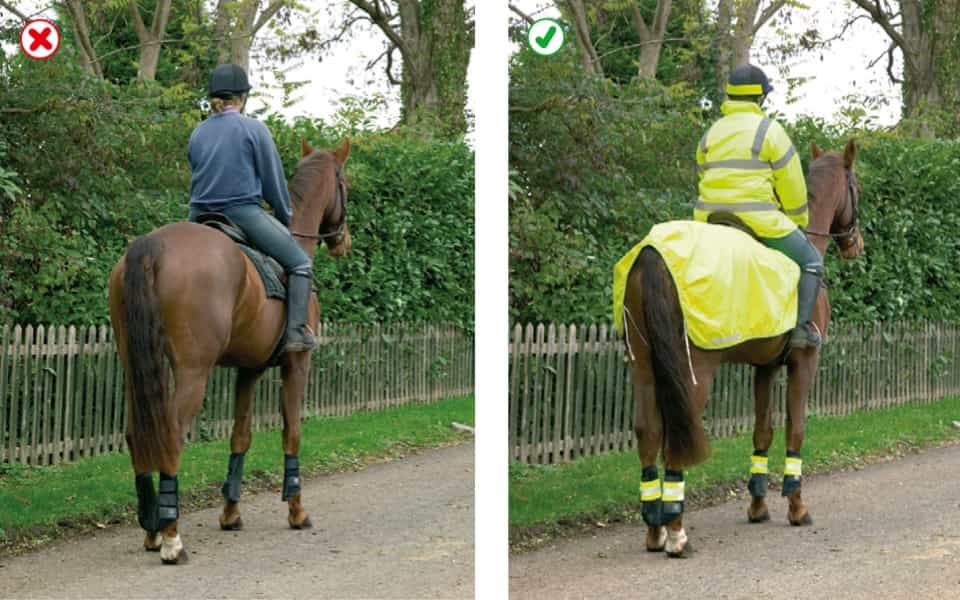
Rule 50: Help yourself to be seen
Rule 51
At night. It is safer not to ride on the road at night or in poor visibility, but if you do, make sure you wear reflective clothing and your horse has reflective bands above the fetlock joints. A light which shows white to the front and red to the rear should be fitted, with a band, to the rider’s right arm and/or leg/riding boot. If you are leading a horse at night, carry a light in your right hand, showing white to the front and red to the rear, and wear reflective clothing on both you and your horse. It is strongly recommended that a fluorescent/reflective tail guard is also worn by your horse.
Riding
Rule 52
Before you take a horse or horse drawn vehicle on to the road, you should
If you are an inexperienced horse rider or have not ridden for a while, consider taking the Ride Safe Award from the British Horse Society. The Ride Safe Award provides a foundation for any horse rider to be safe and knowledgeable when riding in all environments but particularly on the road. For more information, see www.bhs.org.uk
Always ride with other, less nervous horses if you think that your horse will be nervous of traffic. Never ride a horse without both a saddle and bridle.
Rule 53
Before riding off or turning, look behind you to make sure it is safe, then give a clear arm signal.
When riding on the road, you should
Rule 54
You MUST NOT take a horse onto a footpath or pavement, and you should not take a horse onto a cycle track. Use a bridleway where possible. Equestrian crossings may be provided for horse riders to cross the road and you should use these where available (see Rule 27). You should dismount at level crossings where a ‘horse rider dismount’ sign is displayed.
Laws HA 1835 sect 72 & R(S)A sect 129(5)
Rule 55
Avoid roundabouts wherever possible. If you use them, you should
Rule 56
Dogs. Do not let a dog out on the road on its own. Keep it on a short lead when walking on the pavement, road or path shared with cyclists or horse riders.
Rule 57
When in a vehicle make sure dogs or other animals are suitably restrained so they cannot distract you while you are driving or injure you, or themselves, if you stop quickly. A seat belt harness, pet carrier, dog cage or dog guard are ways of restraining animals in cars.
Rule 58
Animals being herded. These should be kept under control at all times. You should, if possible, send another person along the road in front to warn other road users, especially at a bend or the brow of a hill. It is safer not to move animals after dark, but if you do, then wear reflective clothing and ensure that lights are carried (white at the front and red at the rear of the herd).

Rule 59
Clothing. You should avoid clothes that may get tangled in the chain, or in a wheel or may obscure your lights when you are cycling.
Light-coloured or fluorescent clothing can help other road users to see you in daylight and poor light, while reflective clothing and/or accessories (belt, arm or ankle bands)
Rule 59
Clothing. You should avoid clothes that may get tangled in the chain, or in a wheel or may obscure your lights when you are cycling.
Light-coloured or fluorescent clothing can help other road users to see you in daylight and poor light, while reflective clothing and/or accessories (belt, arm or ankle bands) can increase your visibility in the dark.
You should wear a cycle helmet that conforms to current regulations, is the correct size and securely fastened. Evidence suggests that a correctly fitted helmet will reduce your risk of sustaining a head injury in certain circumstances.
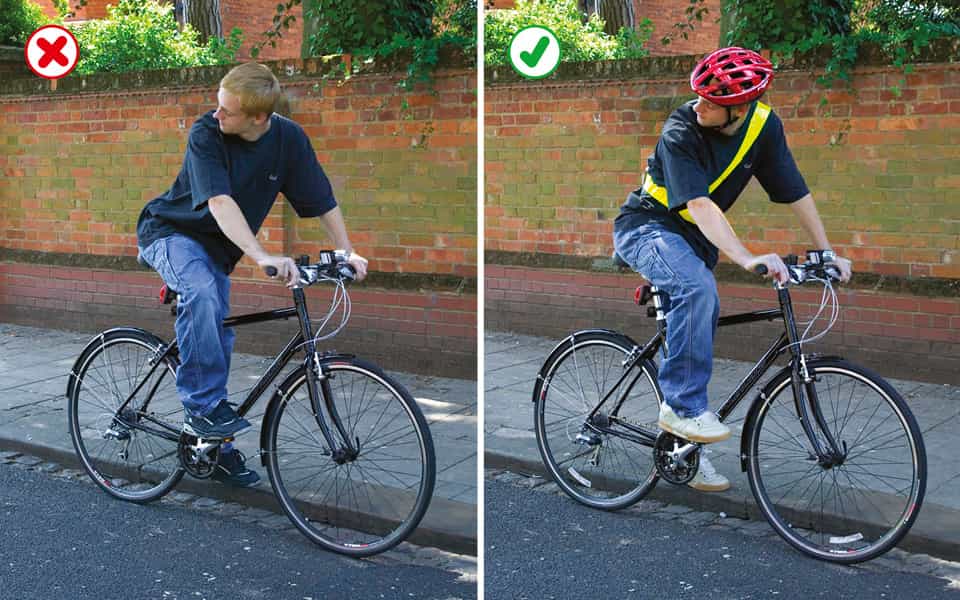
Rule 59: Help yourself to be seen
Rule 60
At night your cycle MUST have white front and red rear lights lit. It MUST also be fitted with a red rear reflector (and amber pedal reflectors, if manufactured after 1/10/85). White front reflectors and spoke reflectors will also help you to be seen. Flashing lights are permitted but it is recommended that cyclists who are riding in areas without street lighting use a steady front lamp.
Law RVLR regs 13, 18 & 24
Rule 61
Cycle Routes and Other Facilities. Cycle lanes are marked by a white line (which may be broken) along the carriageway (see Rule 140). Use facilities such as cycle lanes and tracks, advanced stop lines and toucan crossings (see Rules 62 and 73) where they make your journey safer and easier. This will depend on your experience and skills and the situation at the time. While such facilities are provided for reasons of safety, cyclists may exercise their judgement and are not obliged to use them.
Rule 62
Cycle Tracks. These are routes for cyclists that are physically protected or located away from motor traffic, other than where they cross side roads (see Rule 206). Cycle tracks may run alongside footpaths or pavements and be separated by a feature such as a change of material, a verge, a kerb or a white line. You MUST keep to the side intended for cyclists as the pedestrian side remains a pavement or footpath.
Some cycle tracks shared with pedestrians will not be separated by such a feature. On such shared use routes, you should always take care when passing pedestrians, especially children, older or disabled people, and allow them plenty of room. Always be prepared to slow down and stop if necessary (see Rule H2).
Law HA 1835 sect 72
Rule 63
Sharing space with pedestrians, horse riders and horse drawn vehicles. When riding in places where sharing with pedestrians, horse riders or horse drawn vehicles is permitted, take care when passing pedestrians and horse riders, especially children, older adults or disabled people. Slow down when necessary and let them know you are there; for example, by ringing your bell (it is recommended that a bell is fitted to your bike), or by calling out politely.
Remember that pedestrians may be deaf, blind or partially sighted and that this may not be obvious.
Do not pass pedestrians, horse riders or horse drawn vehicles closely or at high speed, particularly from behind. You should not pass a horse on their left. Remember that horses can be startled if passed without warning. Always be prepared to slow down and stop when necessary.
Rule 64
You MUST NOT cycle on a pavement.
Laws HA 1835 sect 72 & R(S)A sect 129
Rule 65
Bus Lanes. Most bus lanes may be used by cyclists as indicated on signs. Watch out for people getting on or off a bus. Be very careful when overtaking a bus or leaving a bus lane as you will be entering a busier traffic flow. Do not pass between the kerb and a bus when it is at a stop.
Rule 66
You should
Rule 67
You should
Rule 68
You MUST NOT
Law RTA 1988 sects 24, 26, 28, 29 & 30 as amended by RTA 1991
Rule 69
You MUST obey all traffic signs and traffic light signals.
Laws RTA 1988 sect 36 & TSRGD schedule 3 part 3, schedule 7 part 4, schedule 9 parts 4 and 6, schedule 13 part 6, schedule 14 part 2
Rule 70
When parking your cycle
Rule 71
At traffic light junctions and at cycle-only crossings with traffic lights, you MUST NOT cross the stop line when the traffic lights are red.
Some junctions have an advanced stop line to enable you to position yourself ahead of other traffic and wait (see Rule 178). When the traffic lights are red, you may cross the first stop line, but you MUST NOT cross the final stop line.
Laws RTA 1988 sect 36 & TSRGD Schedule 14 part 1
Rule 72
Road positioning. When riding on the roads, there are two basic road positions you should adopt, depending on the situation.
1) Ride in the centre of your lane, to make yourself as clearly visible as possible, in the following situations
2) When riding on busy roads, with vehicles moving faster than you, allow them to overtake where it is safe to do so whilst keeping at least 0.5 metres away, and further where it is safer, from the kerb edge. Remember that traffic on most dual carriageways moves quickly. Take extra care crossing slip roads.
Rule 73
Junctions. Some junctions, particularly those with traffic lights, have special cycle facilities, including small cycle traffic lights at eye-level height, which may allow you to move or cross separately from or ahead of other traffic. Use these facilities where they make your journey safer and easier.
At junctions with no separate cyclist facilities, it is recommended that you proceed as if you were driving a motor vehicle (see Rules 170 to 190).
Position yourself in the centre of your chosen lane, where you feel able to do this safely, to make yourself as visible as possible and to avoid being overtaken where this would be dangerous. If you do not feel safe to proceed in this way, you may prefer to dismount and wheel your bike across the junction.
Rule 74
Turning. When approaching a junction on the left, watch out for vehicles turning in front of you, out of or into the side road. If you intend to turn left, check first for other cyclists or motorcyclists before signalling. Do not ride on the inside of vehicles signalling or slowing down to turn left.
If you are turning right, check the traffic to ensure it is safe, then signal and move to the centre of the road. Wait until there is a safe gap in the oncoming traffic and give a final look before completing the turn. It may be safer to wait on the left until there is a safe gap or to dismount and push your cycle across the road.
When turning into or out of a side road, you should give way to pedestrians crossing or waiting to cross (see Rule H2).
Rule 75
Two Stage Turns. At some signal-controlled junctions there may be signs and markings informing cyclists to turn right in two stages:
Stage 1: When the traffic lights turn green, cyclists wishing to make the turn should go straight ahead to the location marked by a cycle symbol and turn arrow on the carriageway; then stop and wait there
Stage 2: When the traffic lights on the far side of the junction, now facing the cyclists, turn green, they should then complete the manoeuvre
Rule 76
Going straight ahead. If you are going straight ahead at a junction, you have priority over traffic waiting to turn into or out of the side road, unless road signs or markings indicate otherwise (see Rule H3). Check that you can proceed safely, particularly when approaching junctions on the left alongside stationary or slow-moving traffic. Watch out for drivers intending to turn across your path. Remember the driver ahead may not be able to see you, so bear in mind your speed and position in the road.
Take great care when deciding whether it is safe to pass stationary or slow-moving lorries and other long vehicles, especially at the approach to junctions, as their drivers may not be able to see you. Remember that they may have to move over to the right before turning left, and that their rear wheels may then come very close to the kerb while turning (see Rule 67).
Rule 77
Busy roads. When crossing faster or busy main roads, you may find it safer and easier to
Rule 78
Full details about the correct procedure at roundabouts without cycle facilities are contained in Rules 184 to 190.
Watch out for vehicles crossing your path to leave or join the roundabout, remembering that drivers may not easily see you.
Rule 79
If you are turning right, you can ride in the left or right-hand lanes and move left when approaching your exit. Position yourself in the centre of your lane if it is safe to do so (see Rule 72) and signal right to indicate that you are not leaving the roundabout. Alternatively, you may feel safer walking your cycle round on the pavement or verge.
If you decide to ride round keeping to the left-hand lane you should
Where a roundabout has separate cycle facilities, you should use these facilities where they make your journey safer and easier although you are not obliged to use them. This will depend on your experience and skills and the situation at the time.
Rule 80
Give plenty of room to long vehicles on the roundabout as they need more space to manoeuvre. Do not ride in the space they need to get round the roundabout. It may be safer to wait until they have cleared the roundabout.
Rule 81
Do not ride across equestrian crossings, as they are for horse riders only. Do not ride across a pelican, puffin or zebra crossing. Dismount and wheel your cycle across.
Rule 82
Crossings. Toucan crossings are light-controlled crossings which allow cyclists and pedestrians to share crossing space and cross at the same time. They are push-button operated. Pedestrians and cyclists will see the green signal together. Cyclists are permitted to ride across.
Cycle tracks on opposite sides of the road may be linked by cycle-only signalled crossings. You may ride across but you MUST NOT cross until the green cycle symbol is showing.
Cycle track crossings can be in spacious pedestrian environments. Cyclists should look out and be prepared to stop for pedestrians crossing the track informally as well as at these designated points.
Take extra care when crossing level crossings and tramways (see Rule 306). You should dismount at level crossings where a ‘cyclist dismount’ sign is displayed.
Law TSRGD schedule 14 part 1

Rule 83
On all journeys, the rider and pillion passenger on a motorcycle, scooter or moped MUST wear a protective helmet. This does not apply to a follower of the Sikh religion while wearing a turban. Helmets MUST comply with the Regulations and they MUST be fastened securely. Riders and passengers of motor tricycle
Rule 83
On all journeys, the rider and pillion passenger on a motorcycle, scooter or moped MUST wear a protective helmet. This does not apply to a follower of the Sikh religion while wearing a turban. Helmets MUST comply with the Regulations and they MUST be fastened securely. Riders and passengers of motor tricycles and quadricycles, also called quadbikes, should also wear a protective helmet. Before each journey check that your helmet visor is clean and in good condition.
Laws RTA 1988 sects 16 & 17, & MC(PH)R as amended reg 4
Rule 84
It is also advisable to wear eye protectors, which MUST comply with the Regulations. Scratched or poorly fitting eye protectors can limit your view when riding, particularly in bright sunshine and the hours of darkness. Consider wearing ear protection. Strong boots, gloves and suitable clothing may help to protect you if you are involved in a collision.
Laws RTA 1988 sect 18 & MC(EP)R as amended reg 4
Rule 85
You MUST NOT carry more than one pillion passenger who MUST sit astride the machine on a proper seat. They should face forward with both feet on the footrests. You MUST NOT carry a pillion passenger unless your motorcycle is designed to do so. Provisional licence holders MUST NOT carry a pillion passenger.
Laws RTA 1988 sect 23, MV(DL)R reg 16(6) & CUR reg 102
Rule 86
Daylight riding. Make yourself as visible as possible from the side as well as the front and rear. You could wear a light or brightly coloured helmet and fluorescent clothing or strips. Dipped headlights, even in good daylight, may also make you more conspicuous. However, be aware that other vehicle drivers may still not have seen you, or judged your distance or speed correctly, especially at junctions.
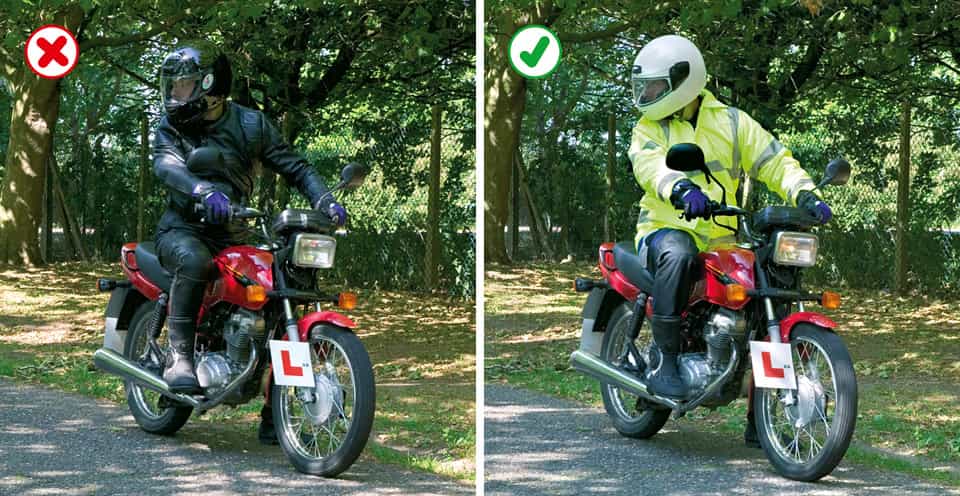
Rule 86: Help yourself to be seen
Rule 87
Riding in the dark. Wear reflective clothing or strips to improve your visibility in the dark. These reflect light from the headlamps of other vehicles, making you visible from a longer distance. See Rules 113 to 116 for lighting requirements.
Rule 88
Manoeuvring. You should be aware of what is behind and to the sides before manoeuvring. Look behind you; use mirrors if they are fitted. When in traffic queues look out for pedestrians crossing between vehicles and vehicles emerging from junctions or changing lanes. Position yourself so that drivers in front can see you in their mirrors. Additionally, when filtering in slow-moving traffic, take care and keep your speed low.
Remember: Observation – Signal – Manoeuvrehere.

Rule 89
Vehicle condition. You MUST ensure your vehicle and trailer comply with the full requirements of the Road Vehicles (Construction and Use) Regulations and Road Vehicles Lighting Regulations (see ‘The road user and the law’).
Rule 90
Make sure that you are fit to drive. You MU
Rule 89
Vehicle condition. You MUST ensure your vehicle and trailer comply with the full requirements of the Road Vehicles (Construction and Use) Regulations and Road Vehicles Lighting Regulations (see ‘The road user and the law’).
Rule 90
Make sure that you are fit to drive. You MUST report to the Driver and Vehicle Licensing Agency (DVLA) any health condition likely to affect your driving.
Law RTA 1988 sect 94
Rule 91
Driving when you are tired greatly increases your risk of collision. To minimise this risk
Rule 92
Vision. You MUST be able to read a vehicle number plate, in good daylight, from a distance of 20 metres (or 20.5 metres where the old style number plate is used). If you need to wear glasses (or contact lenses) to do this, you MUST wear them at all times while driving. The police have the power to require a driver to undertake an eyesight test.
Laws RTA 1988 sect 96, & MV(DL)R reg 40 & sched 8
Rule 93
Slow down, and if necessary stop, if you are dazzled by bright sunlight.
Rule 94
At night or in poor visibility, do not use tinted glasses, lenses or visors if they restrict your vision.
Rule 95
Do not drink and drive as it will seriously affect your judgement and abilities.
In England and Wales you MUST NOT drive with a breath alcohol level higher than 35 microgrammes/100 millilitres of breath or a blood alcohol level of more than 80 milligrammes/100 millilitres of blood.
In Scotland the legal limits are lower. You MUST NOT drive with a breath alcohol level higher than 22 microgrammes/100 millilitres of breath or a blood alcohol level of more than 50 milligrammes/100 millilitres of blood.
Alcohol will
The best solution is not to drink at all when planning to drive because any amount of alcohol affects your ability to drive safely. If you are going to drink, arrange another means of transport.
Laws RTA 1988 sects 4, 5 & 11(2), & PLSR
Rule 96
You MUST NOT drive under the influence of drugs or medicine. For medicines, check with your doctor or pharmacist and do not drive if you are advised that you may be impaired.
You MUST NOT drive if you have illegal drugs or certain medicines in your blood above specified limits. It is highly dangerous so never take illegal drugs if you intend to drive; the effects are unpredictable, but can be even more severe than alcohol and result in fatal or serious road crashes. Illegal drugs have been specified at very low levels so even small amounts of use could be above the specified limits. The limits for certain medicines have been specified at higher levels, above the levels generally found in the blood of patients who have taken normal therapeutic doses. If you are found to have a concentration of a drug above its specified limit in your blood because you have been prescribed or legitimately supplied a particularly high dose of medicine, then you can raise a statutory medical defence, provided your driving was not impaired by the medicine you are taking.
Law RTA 1988 sects 4 & 5
Rule 97
Before setting off. You MUST ensure that
You SHOULD ensure that
It is recommended for emergency use that
Laws RTA 1988 sects 42, 45, 47, 49, 53, 87, 99(4) & 143, MV(DL)R reg 16, 40 & sched 4, VERA sect 29, RVLR 1989 regs 23 & 27, & CUR regs 27, 30, 32 & 61
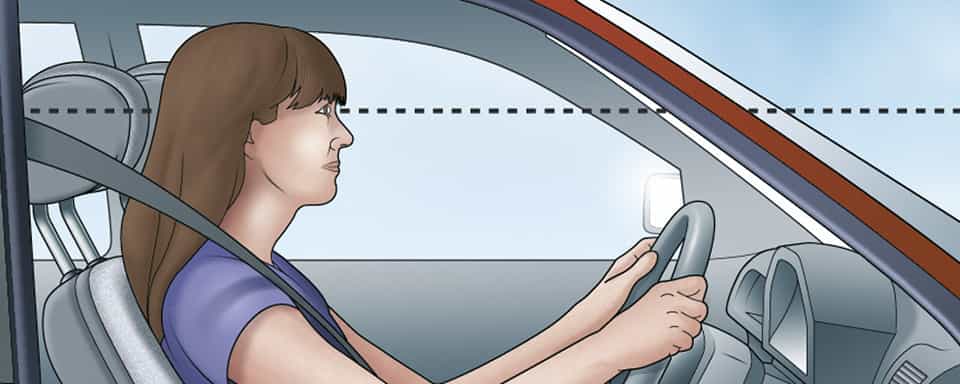
Rule 97: Make sure head restraints are properly adjusted
Rule 98
Before towing. As a driver
During towing. As a driver
Breakdowns. In the event of a breakdown, be aware
For additional advice about towing safely, see Further reading.
Laws CUR regs 27, 33, 86a & 100, RVLR reg 18, MT(E&W)R reg 12 & MV(DL)R reg 6, 7, 76 & sched 2
Rule 99
You MUST wear a seat belt in cars, vans and other goods vehicles if one is fitted (see table below). Adults, and children aged 14 years and over, MUST use a seat belt or child restraint, where fitted, when seated in minibuses, buses and coaches. Exemptions are allowed for the holders of medical exemption certificates and those making deliveries or collections in goods vehicles when travelling less than 50 metres (approx 162 feet).
Laws RTA 1988 sects 14 & 15, MV(WSB)R, MV(WSBCFS)R & MV(WSB)(A)R 2005 & 2006
Seat belt requirements. This table summarises the main legal requirements for wearing seat belts in cars, vans and other goods vehicles.
Front seatRear seatWho is responsible?DriverSeat belt MUSTbe worn if fitted-DriverChildunder 3 years of ageCorrect child restraint MUSTbe usedCorrect child restraint MUSTbe used. If one is not available in a taxi, may travel unrestrained.DriverChild from 3rd birthday up to 1.35 metres in height (or 12th birthday, whichever they reach first)Correct child restraint MUSTbe usedCorrect child restraint MUSTbe used where seat belts fitted. MUSTuse adult belt if correct child restraint is not available in a licensed taxi or private hire vehicle, or for reasons of unexpected necessity over a short distance, or if two occupied restraints prevent fitment of a third.DriverChild over 1.35 metres (approx 4ft 5ins) in height or 12 or 13 yearsSeat belt MUSTbe worn if availableSeat belt MUSTbe worn if availableDriverAdultpassengers aged 14 and overSeat belt MUSTbe worn if availableSeat belt MUSTbe worn if availablePassenger
Rule 100
The driver MUST ensure that all children under 14 years of age in cars, vans and other goods vehicles wear seat belts or sit in an approved child restraint where required (see table above). If a child is under 1.35 metres (approx 4 feet 5 inches) tall, a baby seat, child seat, booster seat or booster cushion MUST be used suitable for the child’s weight and fitted to the manufacturer’s instructions.
Laws RTA 1988 sects 14 & 15, MV(WSB)R, MV(WSBCFS)R & MV(WSB)(A)R 2006
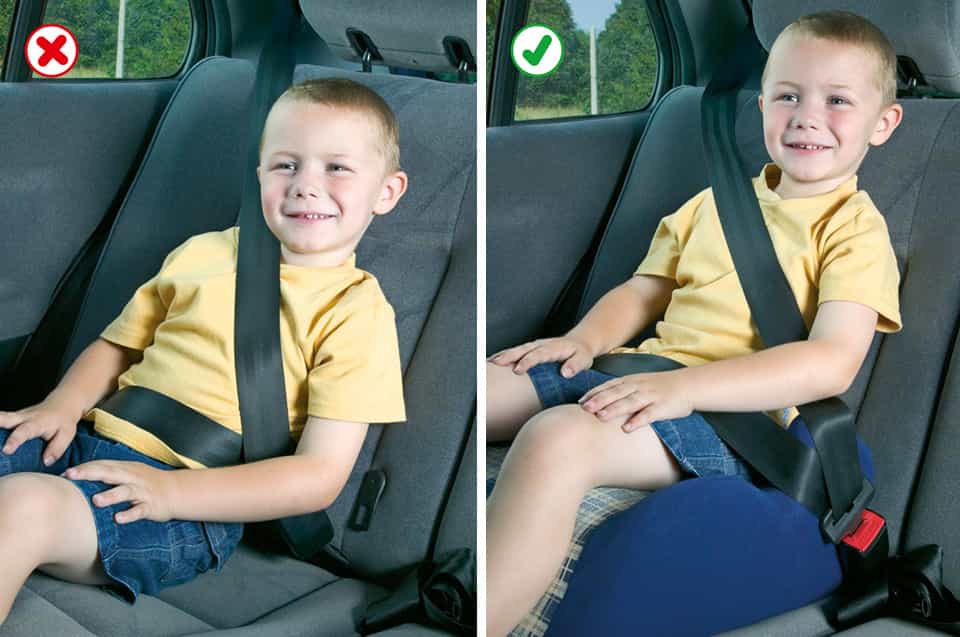
Rule 100: Make sure that a child uses a suitable restraint which is correctly adjusted
Rule 101
A rear-facing baby seat MUST NOT be fitted into a seat protected by an active frontal airbag, as in a crash it can cause serious injury or death to the child.
Laws RTA 1988 sects 14 & 15, MV(WSB)R, MV(WSBCFS)R & MV(WSB)(A)R 2006
Rule 102
Children in cars, vans and other goods vehicles. Drivers who are carrying children in cars, vans and other goods vehicles should also ensure that

Rule 103
Signals warn and inform other road users, including pedestrians (see ‘Signals to other road users), of your intended actions. You should always
Rule 103
Signals warn and inform other road users, including pedestrians (see ‘Signals to other road users), of your intended actions. You should always
Rule 104
You should also
Rule 105
You MUST obey signals given by police officers, traffic officers, traffic wardens (see ‘Signals by authorised persons’) and signs used by school crossing patrols.
Laws RTRA sect 28, RTA 1988 sect 35, TMA sect 6 & FTWO art 3
Rule 106
Police stopping procedures. If the police want to stop your vehicle they will, where possible, attract your attention by
You MUST then pull over and stop as soon as it is safe to do so. Then switch off your engine.
Law RTA 1988 sect 163
Rule 107
Driver and Vehicle Standards Agency officers have the power to stop vehicles on all roads, including motorways and trunk roads. They will attract your attention by flashing amber lights
It is an offence not to comply with their directions. You MUST obey any signals given (see ‘Signals by authorised persons’).
Laws RTA 1988 sect 67, & PRA sect 41 & sched 5(8)
Rule 108
Traffic officers have powers to stop vehicles on most motorways and some ‘A’ class roads, in England and Wales. If traffic officers in uniform want to stop your vehicle on safety grounds (e.g. an insecure load) they will, where possible, attract your attention by
You MUST then pull over and stop as soon as it is safe to do so. Then switch off your engine. It is an offence not to comply with their directions (see ‘Signals by authorised persons’).
Law RTA 1988 sects 35 & 163 as amended by TMA sect 6
Rule 109
Traffic light signals and traffic signs. You MUST obey all traffic light signals (see ‘Light signals controlling traffic’) and traffic signs giving orders, including temporary signals & signs (see ‘Traffic signs’). Make sure you know, understand and act on all other traffic and information signs and road markings (see ‘Traffic signs’, ‘Road markings’ and ‘Vehicle markings’).
Laws RTA 1988 sect 36 & TSRGD schedule 3 part 4, schedule 9 parts 7 and 8, schedule 14 parts 1 and 5, schedule 7 part 6, schedule 15 part 1
Rule 110
Flashing headlights. Only flash your headlights to let other road users know that you are there. Do not flash your headlights to convey any other message or intimidate other road users.
Rule 111
Never assume that flashing headlights is a signal inviting you to proceed. Use your own judgement and proceed carefully.
Rule 112
The horn. Use only while your vehicle is moving and you need to warn other road users of your presence. Never sound your horn aggressively. You MUST NOT use your horn
except when another road user poses a danger.
Law CUR reg 99
Rule 113
You MUST
Night (the hours of darkness) is defined as the period between half an hour after sunset and half an hour before sunrise.
Laws RVLR regs 3, 24 & 25 (In Scotland - RTRA sect 82 (as amended by NRSWA, para 59 of sched 8))
Rule 114
You MUST NOT
In stationary queues of traffic, drivers should apply the parking brake and, once the following traffic has stopped, take their foot off the footbrake to deactivate the vehicle brake lights. This will minimise glare to road users behind until the traffic moves again.
Law RVLR reg 27
Rule 115
You should also
Rule 116
Hazard warning lights. These may be used when your vehicle is stationary, to warn that it is temporarily obstructing traffic. Never use them as an excuse for dangerous or illegal parking. You MUST NOT use hazard warning lights while driving or being towed unless you are on a motorway or unrestricted dual carriageway and you need to warn drivers behind you of a hazard or obstruction ahead. Only use them for long enough to ensure that your warning has been observed.
Law RVLR reg 27
Braking
Rule 117
In normal circumstances. The safest way to brake is to do so early and lightly. Brake more firmly as you begin to stop. Ease the pressure off just before the vehicle comes to rest to avoid a jerky stop.
Rule 118
In an emergency. Brake immediately. Try to avoid braking so harshly that you lock your wheels. Locked wheels can lead to loss of control.
Rule 119
Skids. Skidding is usually caused by the driver braking, accelerating or steering too harshly or driving too fast for the road conditions. If skidding occurs, remove the cause by releasing the brake pedal fully or easing off the accelerator. Turn the steering wheel in the direction of the skid. For example, if the rear of the vehicle skids to the right, steer immediately to the right to recover.
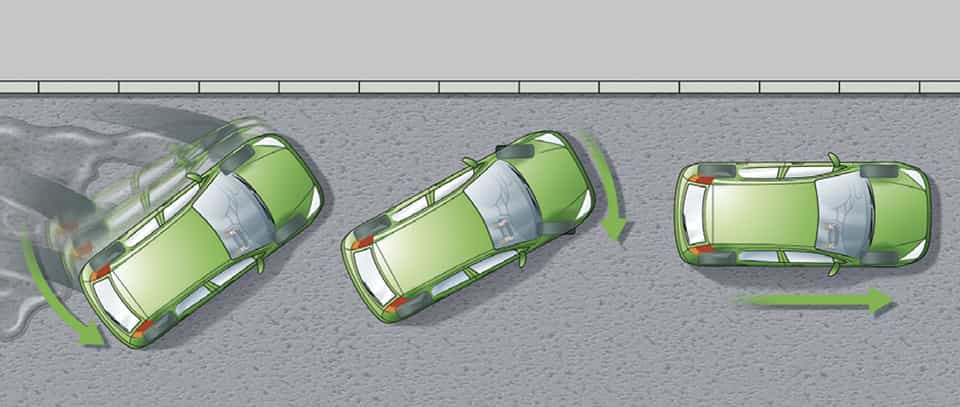
Rule 119: Rear of the car skids to the right. Driver steers to the right
Rule 120
ABS. If your vehicle is fitted with anti-lock brakes, you should follow the advice given in the vehicle handbook. However, in the case of an emergency, apply the footbrake firmly; do not release the pressure until the vehicle has slowed to the desired speed. The ABS should ensure that steering control will be retained, but do not assume that a vehicle with ABS will stop in a shorter distance.
Rule 121
Brakes affected by water. If you have driven through deep water your brakes may be less effective. Test them at the first safe opportunity by pushing gently on the brake pedal to make sure that they work. If they are not fully effective, gently apply light pressure while driving slowly. This will help to dry them out.
Rule 122
Coasting. This term describes a vehicle travelling in neutral or with the clutch pressed down. It can reduce driver control because
Rule 123
The Driver and the Environment. You MUST NOT leave a parked vehicle unattended with the engine running or leave a vehicle engine running unnecessarily while that vehicle is stationary on a public road. Generally, if the vehicle is stationary and is likely to remain so for more than a couple of minutes, you should apply the parking brake and switch off the engine to reduce emissions and noise pollution. However it is permissible to leave the engine running if the vehicle is stationary in traffic or for diagnosing faults.
Law CUR regs 98 & 107
Rule 124
You MUST NOT exceed the maximum speed limits for the road and for your vehicle (see the speed limits table). A speed limit of 30 mph (48 km/h) generally applies to all roads with street lights (excluding motorways) unless signs show otherwise.
Speed limits
Speed LimitsBuilt-up areasSingle carriagewaysDual carriagewaysMotorwaysType of vehiclemph (km/h)mph (km/h)mph (km/h)mph (km/h)Cars & motorcycles(including car derived vans up to 2 tonnes maximum laden weight)30(48)60 (96)70 (112)70 (112)Cars towing caravans or trailers(including car derived vans and motorcycles)30(48)50 (80)60 (96)60 (96)Motorhomes or motor caravans(not exceeding 3.05 tonnes maximum unladen weight)30(48)60 (96)70 (112)70 (112)Motorhomes or motor caravans(exceeding 3.05 tonnes maximum unladen weight)30(48)50 (80)60 (96)70 (112)Buses, coaches and minibuses(not exceeding 12 metres in overall length)30(48)50 (80)60 (96)70† (112)Goods vehicles(not exceeding 7.5 tonnes maximum laden weight)30(48)50 (80)60 (96)70†† (112)Goods vehicles(exceeding 7.5 tonnes maximum laden weight) in England and Wales30(48)50 (80)60 (96)60 (96)Goods vehicles(exceeding 7.5 tonnes maximum laden weight) in Scotland30(48)40 (64)50 (80)60 (96)
† 60 mph (96 km/h) if exceeding 12 metres in overall length.
†† 60 mph (96 km/h) if articulated or towing a trailer.
For speed limits that apply to special types of vehicles, such as oversized vehicles, see Further reading.
Locally set speed limits may apply, for example
Speed limits are enforced by the police.
Law RTRA sects 81, 86, 89 & sched 6 as amended by MV(VSL)(E&W)
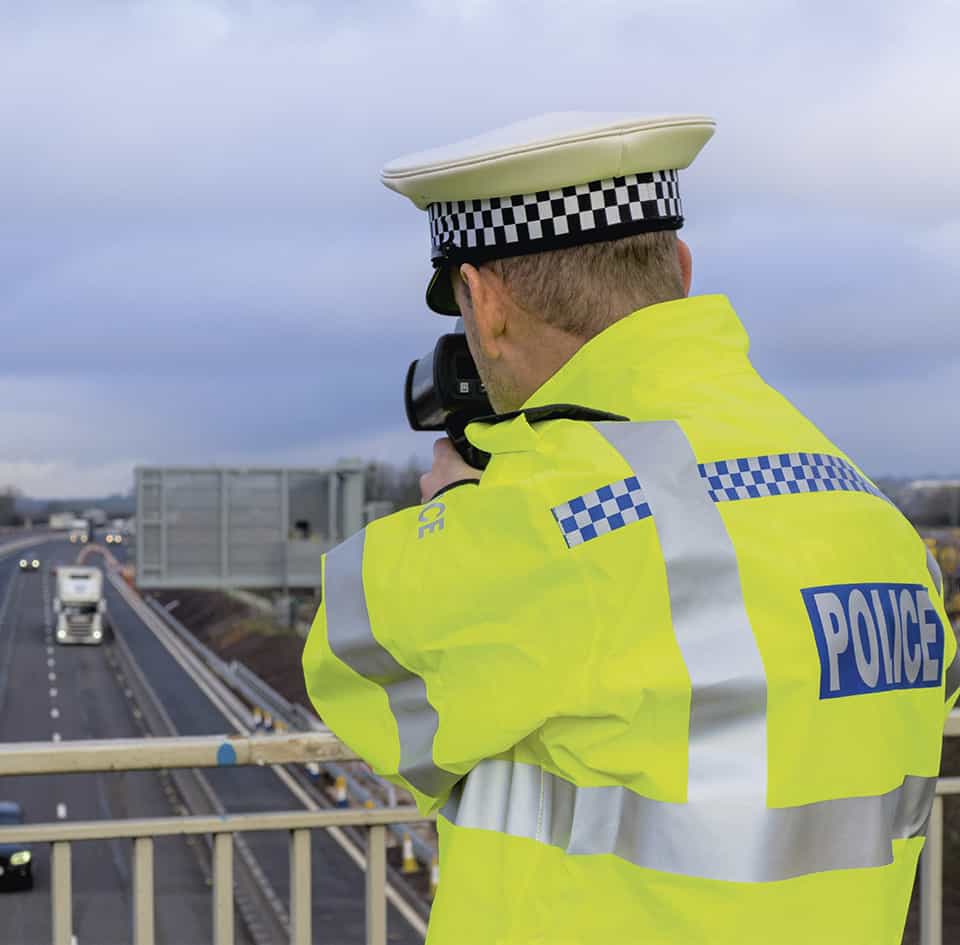
Rule 124: Examples of speed enforcement

Rule 124: Examples of speed enforcement
Rule 125
The speed limit is the absolute maximum and does not mean it is safe to drive at that speed irrespective of conditions. Unsafe speed increases the chances of causing a collision (or being unable to avoid one), as well as its severity. Inappropriate speeds are also intimidating, deterring people from walking, cycling or riding horses. Driving at speeds too fast for the road and traffic conditions is dangerous. You should always reduce your speed when
Rule 126

Stopping distances. Drive at a speed that will allow you to stop well within the distance you can see to be clear.
You should
If you have to stop in a tunnel, leave at least a 5-metre gap between you and the vehicle in front.
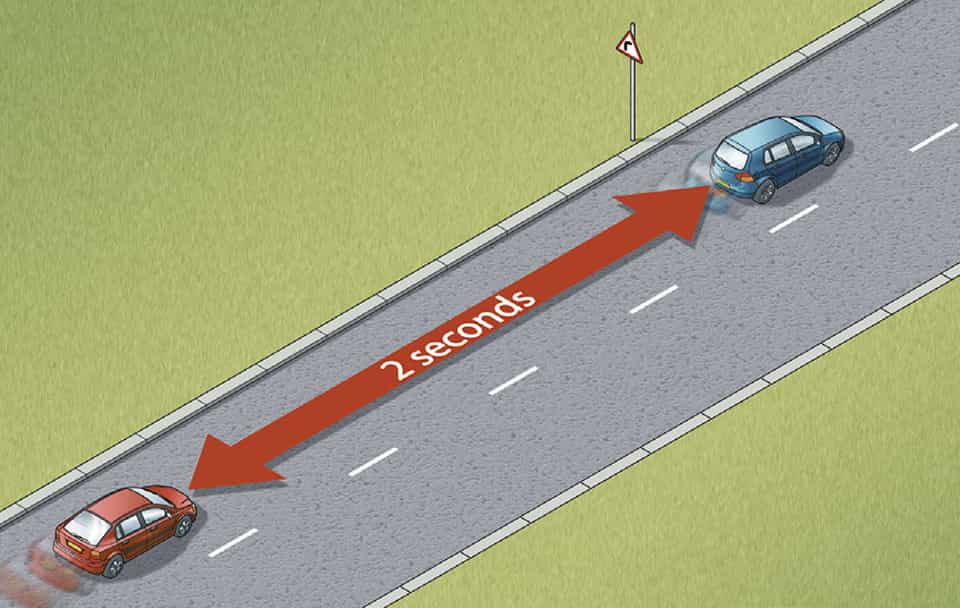
Rule 126: Use a fixed point such as a sign to help measure a two-second gap
Tailgating is where the gap between you and the vehicle in front is too small for you to be able to stop safely if the vehicle in front suddenly brakes.
Tailgating is dangerous, intimidating and can cause collisions, especially when driving at speed. Keeping a safe distance from the vehicle in front gives you time to react and stop if necessary. Dangerous and careless driving offences, such as tailgating, are enforced by the police.
See ‘Road markings’ to see diagrams of all lines.
Rule 127
A broken white line. This marks the centre of the road. When this line lengthens and the gaps shorten, it means that there is a hazard ahead. Do not cross it unless you can see the road is clear and wish to overtake or turn off.
Rule 128
Double white lines where the line nearest to you is broken. This means you may cross the lines to overtake if it is safe, provided you can complete the manoeuvre before reaching a solid white line on your side. White direction arrows on the road indicate that you need to get back onto your side of the road.
Rule 129
Double white lines where the line nearest you is solid. This means you MUST NOT cross or straddle it unless it is safe and you need to enter adjoining premises or a side road. You may cross the line if necessary, provided the road is clear, to pass a stationary vehicle, or overtake a pedal cycle, horse or road maintenance vehicle, if they are travelling at 10 mph (16 km/h) or less.
Laws RTA 1988 sect 36 & TSRGD schedule 9 part 8
Rule 130
Areas of white diagonal stripes or chevrons painted on the road. These are to separate traffic lanes or to protect traffic turning right.
Laws MT(E&W)R regs 5, 9, 10 & 16, MT(S)R regs 4, 8, 9 & 14, RTA 1988 sect 36 & TSRGD schedule 9 part 8
Rule 131
Lane dividers. These are short, broken white lines which are used on wide carriageways to divide them into lanes. You should keep between them.
Rule 132
Reflective road studs may be used with white lines.
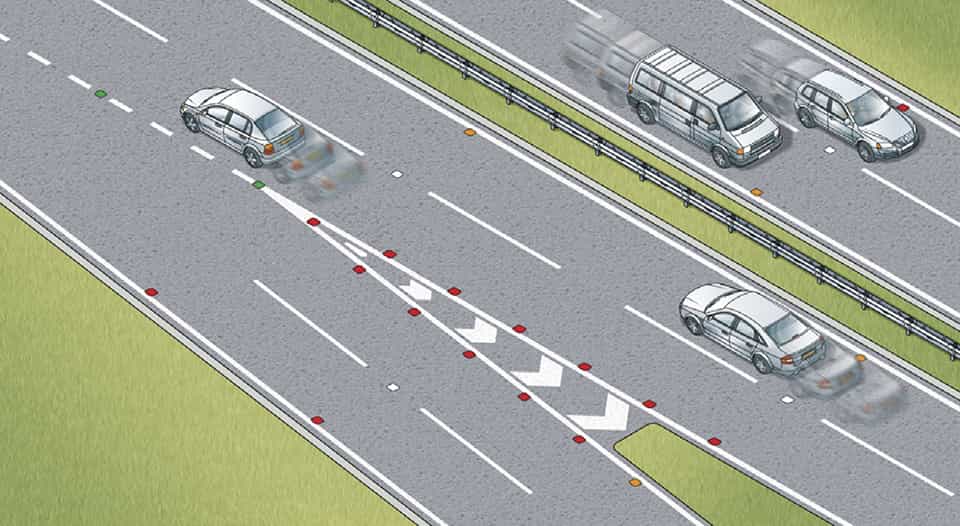
Rule 132: Reflective road studs mark the lanes and edge of the carriageway
Lane discipline
Rule 133
If you need to change lane, first use your mirrors and if necessary take a quick sideways glance to make sure you will not force another road user to change course or speed. When it is safe to do so, signal to indicate your intentions to other road users and when clear, move over.
Rule 134
You should follow the signs and road markings and get into the lane as directed. In congested road conditions do not change lanes unnecessarily. Merging in turn is recommended but only if safe and appropriate when vehicles are travelling at a very low speed, e.g. when approaching road works or a road traffic incident. It is not recommended at high speed.
Single carriageway
Rule 135
Where a single carriageway has three lanes and the road markings or signs do not give priority to traffic in either direction
Rule 136
Where a single carriageway has four or more lanes, use only the lanes that signs or markings indicate.
Dual carriageways
A dual carriageway is a road which has a central reservation to separate the carriageways.
Rule 137
On a two-lane dual carriageway you should stay in the left-hand lane. Use the right-hand lane for overtaking or turning right. After overtaking, move back to the left-hand lane when it is safe to do so.
Rule 138
On a dual carriageway with three or more lanes, you may use the middle lanes or the right-hand lane to overtake but you should return to the middle lanes and then the left-hand lane when it is safe to do so.
Rule 139
Climbing and crawler lanes. These are provided on some hills. Use this lane if you are driving a slow-moving vehicle or if there are vehicles behind you wishing to overtake. Be aware of the signs and road markings which indicate the lane is about to end.
Rule 140
Cycle lanes and cycle tracks. Cycle lanes are shown by road markings and signs. You MUST NOT drive or park in a cycle lane marked by a solid white line during its times of operation. Do not drive or park in a cycle lane marked by a broken white line unless it is unavoidable. You MUST NOT park in any cycle lane whilst waiting restrictions apply.
You should give way to any cyclists in a cycle lane, including when they are approaching from behind you – do not cut across them when you are turning or when you are changing lane (see Rule H3). Be prepared to stop and wait for a safe gap in the flow of cyclists before crossing the cycle lane.
Cycle tracks are routes for cyclists that are physically protected or located away from motor traffic, other than where they cross side roads. Cycle tracks may be shared with pedestrians.
You should give way to cyclists approaching or using the cycle track when you are turning into or out of a junction (see Rule H3). Be prepared to stop and wait for a safe gap in the flow of cyclists before crossing the cycle track, which may be used by cyclists travelling in both directions.
Bear in mind that cyclists are not obliged to use cycle lanes or cycle tracks.
Law RTRA sects 5 & 8
Rule 141
Bus lanes. These are shown by road markings and signs that indicate which (if any) other vehicles are permitted to use the bus lane. Unless otherwise indicated, you should not drive in a bus lane during its period of operation. You may enter a bus lane to stop, to load or unload where this is not prohibited.
Rule 142
High-occupancy vehicle lanes and other designated vehicle lanes. Lanes may be restricted for use by particular types of vehicle; these restrictions may apply some or all of the time. The operating times and vehicle types will be indicated on the accompanying traffic signs. You MUST NOT drive in such lanes during their times of operation unless signs indicate that your vehicle is permitted (see ‘Traffic signs’).
Vehicles permitted to use designated lanes may or may not include cycles, buses, taxis, licensed private hire vehicles, motorcycles, heavy goods vehicles (HGVs) and high-occupancy vehicles (HOVs).
Where HOV lanes are in operation, they MUST ONLY be used by
Laws RTRA sects 5 & 8, & RTA 1988 sect 36
Rule 143
One-way streets. Traffic MUST travel in the direction indicated by signs. Buses and/or cycles may have a contraflow lane. Choose the correct lane for your exit as soon as you can. Do not change lanes suddenly. Unless road signs or markings indicate otherwise, you should use
Laws RTA 1988 sect 36 & RTRA sects 5 & 8
Rule 144
You MUST NOT
Driving requires focus and attention at all times. Remember, you may be driving dangerously or travelling too fast even if you don’t mean to.
Law RTA 1988 sects 2 & 3 as amended by RTA 1991
Rule 145
You MUST NOT drive on or over a pavement, footpath or bridleway except to gain lawful access to property, or in the case of an emergency.
Laws HA 1835 sect 72 & RTA 1988 sect 34
Rule 146
Adapt your driving to the appropriate type and condition of road you are on. In particular
Rule 147
Be considerate. Be careful of and considerate towards all types of road users, especially those requiring extra care (see Rule 204).
Law EPA sect 87
Rule 148
Safe driving and riding needs concentration. Avoid distractions when driving or riding such as
You MUST NOT smoke in public transport vehicles or in vehicles used for work purposes in certain prescribed circumstances. Separate regulations apply to England, Wales and Scotland. In England and Wales, the driver MUST NOT smoke or allow anyone to smoke in an enclosed private vehicle carrying someone under 18, including motor caravans. In Scotland it is an offence for anyone aged 18 or over to smoke in a private motor vehicle (unless it is parked and being used as living accommodation) when there is someone under 18 in the vehicle and the vehicle is in a public place.
Laws TSf(EV)R, TSfP(W)R, TPSCP(S)R, S-f(PV)R, S-f(W)R & SP(CIMV)(S)A
Mobile phones and in-vehicle technology
Rule 149
You MUST exercise proper control of your vehicle at all times. You MUST NOT use a hand-held mobile phone, or similar device, capable of interactive communication (such as a tablet) for any purpose when driving or when supervising a learner driver. This ban covers all use of a hand-held interactive communication device and it applies even when the interactive communication capability is turned off or unavailable. You MUST NOT pick up the phone or similar device while driving to dial a number and then put it in the cradle for the duration of the conversation. You MUST NOT pick up and use your hand-held phone or similar device while stationary in traffic.
There is an exception to call 999 or 112 in a genuine emergency when it is unsafe or impractical to stop. There is also an exception if you are using a hand-held mobile phone or similar device to make a contactless payment at a contactless payment terminal. Your vehicle MUST be stationary, and the goods or services MUST be received at the same time as, or after, the contactless payment.
Never use a hand-held microphone when driving. Using hands-free equipment is also likely to distract your attention from the road. It is far safer not to use any telephone or similar device while you are driving or riding - find a safe place to stop first or use the voicemail facility and listen to messages later.
You may park your vehicle using a handheld remote control app or device. The app or device MUST be legal, and you should not put other people in danger when you use it.
Laws RTA 1988 sects 2 & 3, & CUR regs 104 & 110
Rule 150
There is a danger of driver distraction being caused by in-vehicle systems such as satellite navigation systems, congestion warning systems, PCs, multi-media, etc. You MUST exercise proper control of your vehicle at all times. Do not rely on driver assistance systems such as motorway assist, lane departure warnings, or remote control parking. They are available to assist but you should not reduce your concentration levels. Do not be distracted by maps or screen-based information (such as navigation or vehicle management systems) while driving or riding. If necessary find a safe place to stop.
As the driver, you are still responsible for the vehicle if you use a driver assistance system (like motorway assist). This is also the case if you use a hand-held remote control parking app or device. You MUST have full control over these systems at all times.
Laws RTA 1988 sects 2 & 3, & CUR reg 104 & 110
Rule 151
In slow-moving traffic. You should
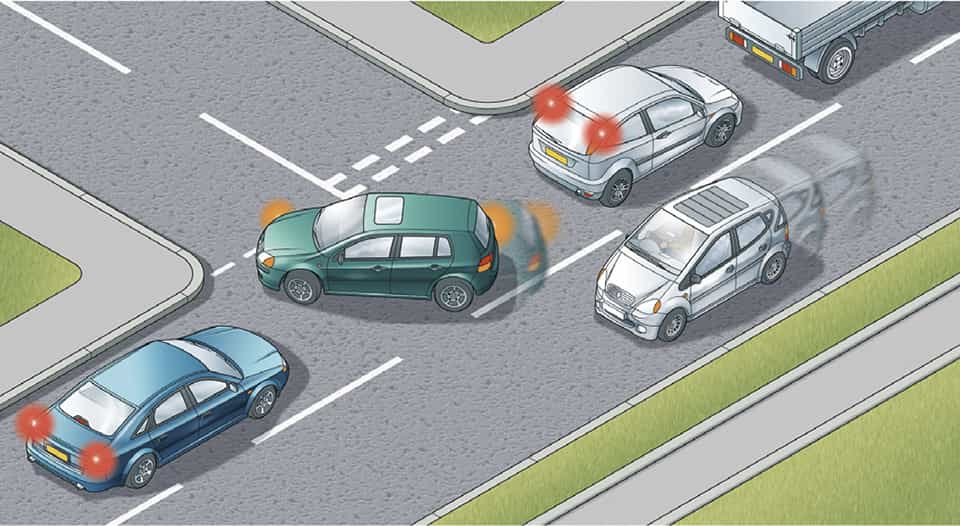
Rule 151: Do not block access to a side road
Driving in built-up areas
Rule 152
Residential streets. You should drive slowly and carefully on streets where there are likely to be pedestrians, cyclists and parked cars. In some areas a 20 mph (32 km/h) maximum speed limit may be in force. Look out for
Rule 153
Traffic-calming measures. On some roads there are features such as road humps, chicanes and narrowings which are intended to slow you down. When you approach these features reduce your speed. Allow cyclists and motorcyclists room to pass through them. Maintain a reduced speed along the whole of the stretch of road within the calming measures. Give way to oncoming road users if directed to do so by signs. You should not overtake other moving road users while in these areas.
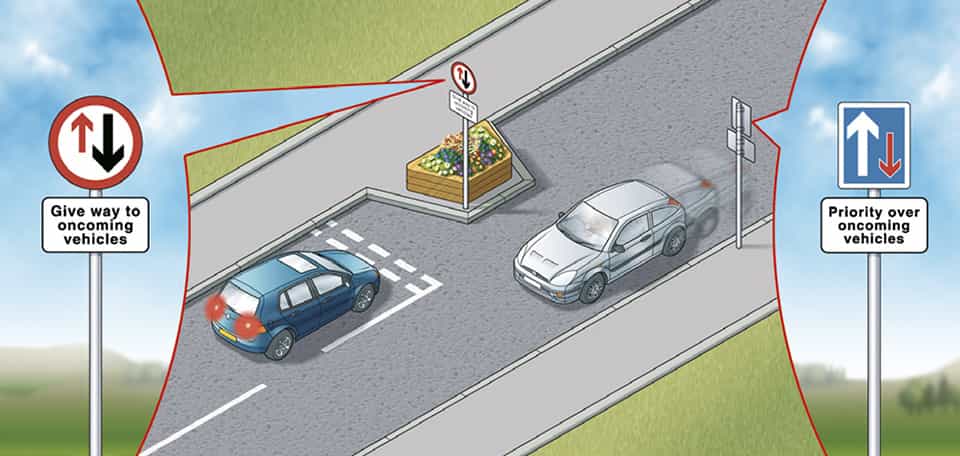
Rule 153: Chicanes may be used to slow traffic down
Country roads
Rule 154
Take extra care on country roads and reduce your speed at approaches to bends, which can be sharper than they appear, and at junctions and turnings, which may be partially hidden. Be prepared for pedestrians, horse riders, cyclists, slow-moving farm vehicles or mud on the road surface. Make sure you can stop within the distance you can see to be clear. You should also reduce your speed where country roads enter villages.
Rule 155
Single-track roads. These are only wide enough for one vehicle. They may have special passing places. If you see a vehicle coming towards you, or the driver behind wants to overtake, pull into a passing place on your left, or wait opposite a passing place on your right. Give way to road users coming uphill whenever you can. If necessary, reverse until you reach a passing place to let the other vehicle pass. Slow down when passing pedestrians, cyclists and horse riders.
Rule 156
Do not park in passing places.
Vehicles prohibited from using roads and pavements
Rule 157
Certain motorised vehicles do not meet the construction and technical requirements for road vehicles and are generally not intended, not suitable and not legal for road, pavement, footpath, cycle path or bridleway use. These include most types of miniature motorcycles, also called mini motos, and motorised scooters, also called go peds, which are powered by electric or internal combustion engines. These types of vehicle MUST NOT be used on roads, pavements, footpaths or bridleways.
Laws RTA 1988 sects 34, 41a, 42, 47, 63 & 66, HA 1835 sect 72 & R(S)A sect 129
Rule 158
Certain models of motorcycles, motor tricycles and quadricycles, also called quad bikes, are suitable only for off-road use and do not meet legal standards for use on roads. Vehicles that do not meet these standards MUST NOT be used on roads. They MUST NOT be used on pavements, footpaths, cycle paths or bridleways either. You MUST make sure that any motorcycle, motor tricycle, quadricycle or any other motor vehicle meets legal standards and is properly registered, taxed and insured before using it on the roads. Even when registered, taxed and insured for the road, vehicles MUST NOT be used on pavements.
Laws RTA 1988 sects 34, 41a, 42, 47, 63, 66 & 156, HA 1835 sect 72, R(S)A sect 129 & VERA sects 1, 29, 31A & 43A

Rule 159
Before moving off you should
Move off only when it is safe to do so.
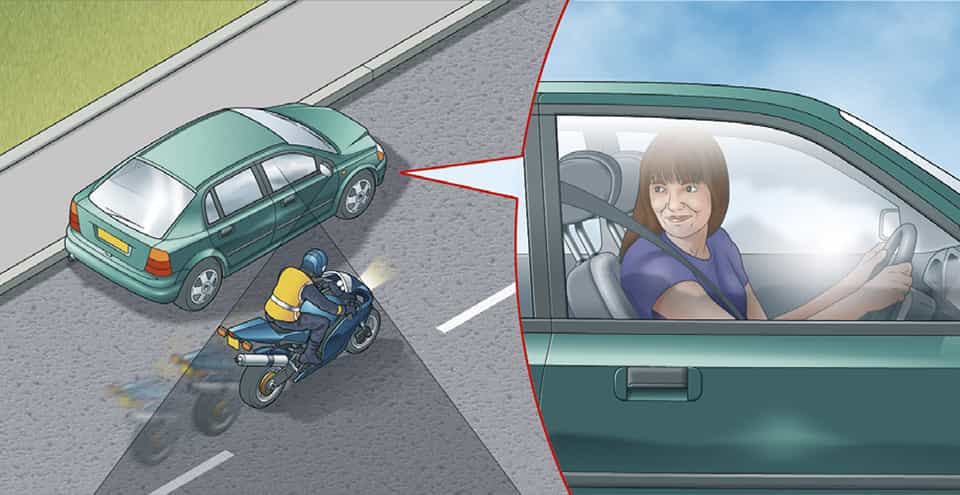
Rule 159: Check the blind spot before m
Rule 159
Before moving off you should
Move off only when it is safe to do so.

Rule 159: Check the blind spot before moving off
Rule 160
Once moving you should
Rule 161
Mirrors. All mirrors should be used effectively throughout your journey. You should
Remember: Mirrors – Signal – Manoeuvre
Rule 162
Before overtaking you should make sure
Rule 163
Overtake only when it is safe and legal to do so. You should
Remember: Mirrors – Signal – Manoeuvre
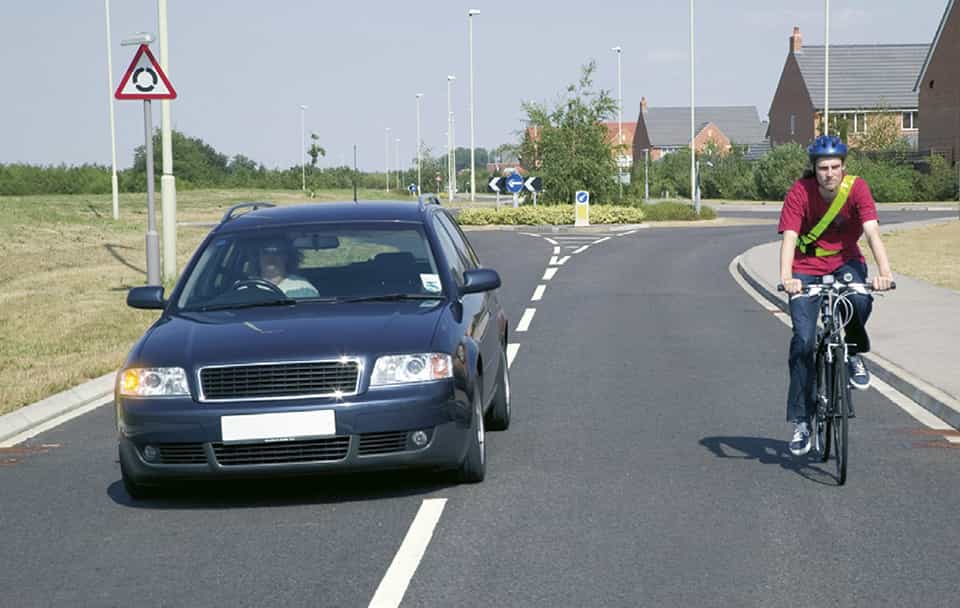
Rule 163: Give vulnerable road users at least as much space as you would a car
Rule 164
Large vehicles. Overtaking these is more difficult. You should
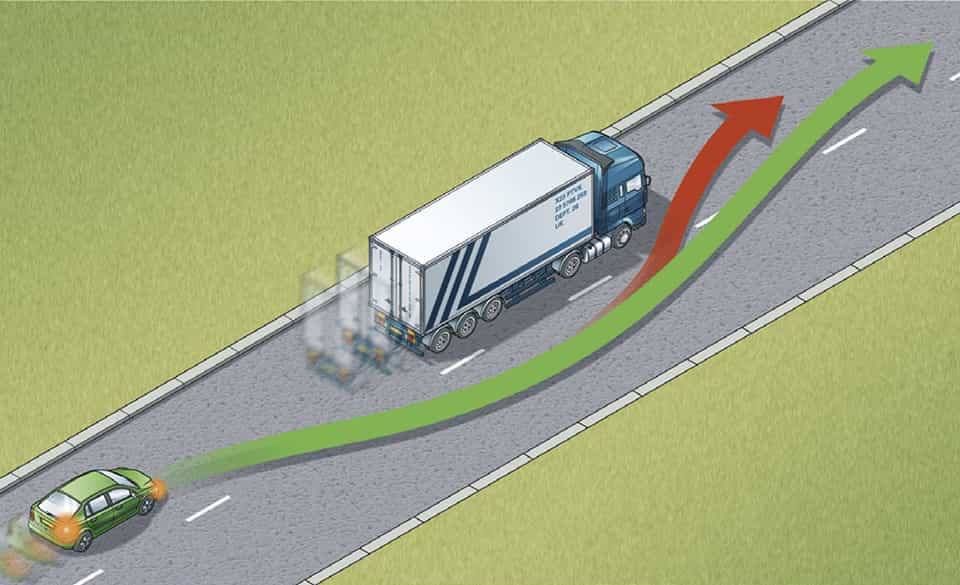
Rule 164: Do not cut in too quickly
Rule 165
You MUST NOT overtake
Laws RTA 1988 sect 36 & TSRGD schedule 1, schedule 9 part 7, schedule 14 part 1
Rule 166
DO NOT overtake if there is any doubt, or where you cannot see far enough ahead to be sure it is safe. For example, when you are approaching
Rule 167
DO NOT overtake where you might come into conflict with other road users. For example
Rule 168
Being overtaken. If a driver is trying to overtake you, maintain a steady course and speed, slowing down if necessary to let the vehicle pass. Never obstruct drivers who wish to pass. Speeding up or driving unpredictably while someone is overtaking you is dangerous. Drop back to maintain a two-second gap if someone overtakes and pulls into the gap in front of you.
Rule 169
Do not hold up a long queue of traffic, especially if you are driving a large or slow-moving vehicle. Check your mirrors frequently, and if necessary, pull in where it is safe and let traffic pass.
Rule 170
Take extra care at junctions. You should
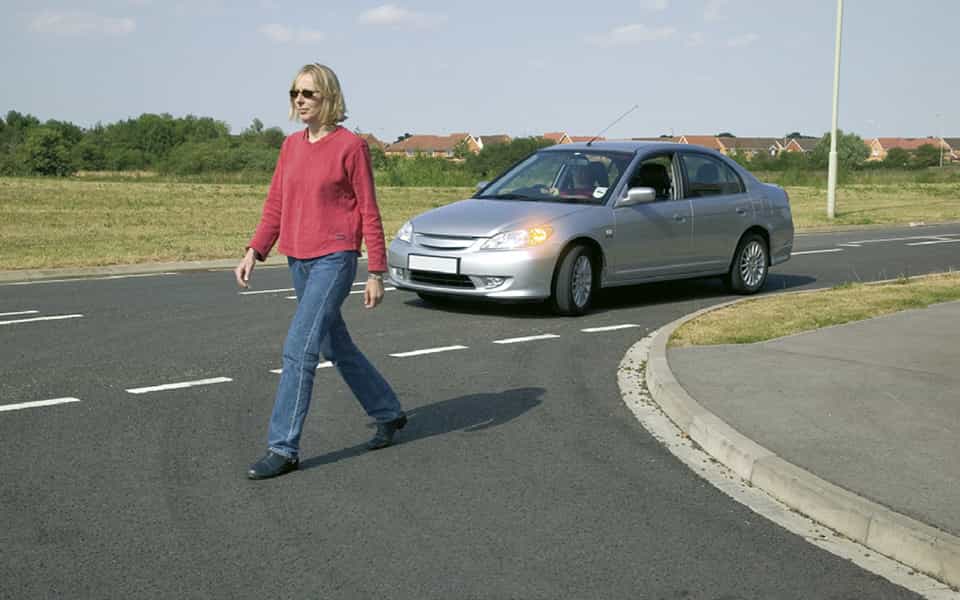
Rule 170: Give way to pedestrians who have started to cross
Rule 171
You MUST stop behind the line at a junction with a ‘Stop’ sign and a solid white line across the road. Wait for a safe gap in the traffic before you move off.
Laws RTA 1988 sect 36 & TSRGD schedule 9 parts 7 and 8
Rule 172
The approach to a junction may have a ‘Give Way’ sign or a triangle marked on the road. You MUST give way to traffic on the main road when emerging from a junction with broken white lines across the road.
Laws RTA 1988 sect 36 & TSRGD schedule 9 parts 7 and 8
Rule 173
Dual carriageways. When crossing or turning right, first assess whether the central reservation is deep enough to protect the full length of your vehicle.
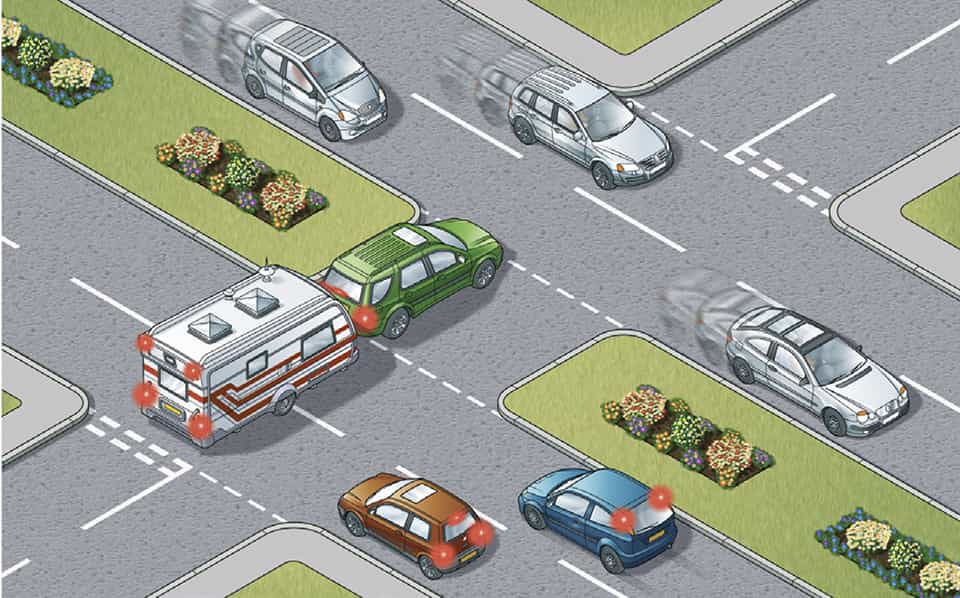
Rule 173: Assess your vehicle’s length and do not obstruct traffic
Rule 174
Box junctions. These have criss-cross yellow lines painted on the road (see ‘Road markings’). You MUST NOT enter the box until your exit road or lane is clear. However, you may enter the box and wait when you want to turn right, and are only stopped from doing so by oncoming traffic, or by other vehicles waiting to turn right. At signalled roundabouts you MUST NOT enter the box unless you can cross over it completely without stopping.
Law TSRGD schedule 9 parts 7 and 8
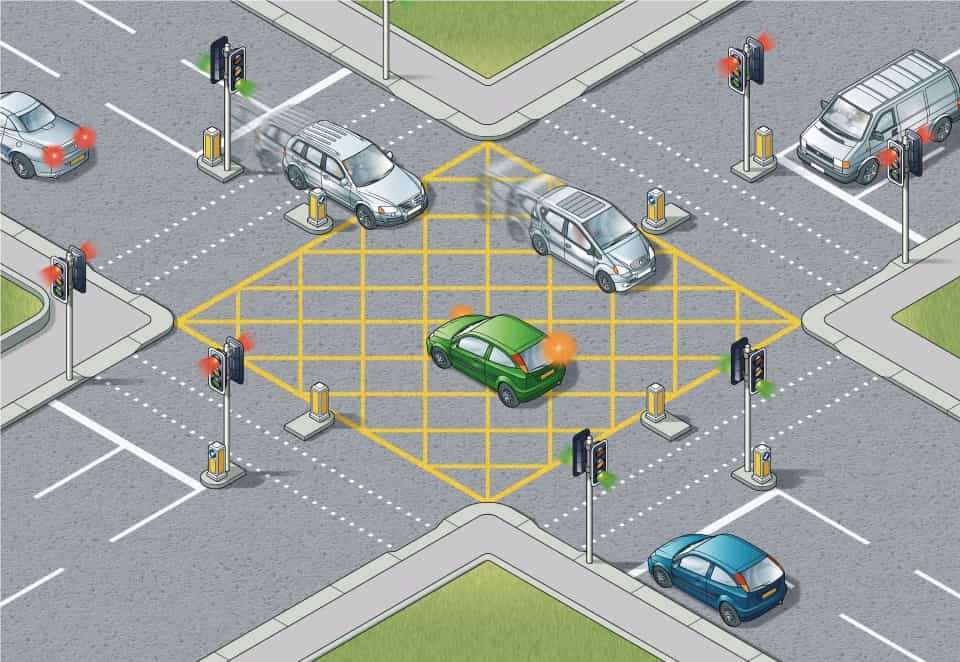
Rule 174: Enter a box junction only if your exit road is clear
Junctions controlled by traffic lights
Rule 175
You MUST stop behind the white ‘Stop’ line across your side of the road unless the light is green. If the amber light appears you may go on only if you have already crossed the stop line or are so close to it that to stop might cause a collision.
Laws RTA 1988 sect 36 & TSRGD schedule 14 parts 1 and 4
Rule 176
You MUST NOT move forward over the white line when the red light is showing. Only go forward when the traffic lights are green if there is room for you to clear the junction safely or you are taking up a position to turn right. If the traffic lights are not working, treat the situation as you would an unmarked junction and proceed with great care.
Laws RTA 1988 sect 36 & TSRGD schedule 14 parts 1 and 4
Rule 177
Green filter arrow. This indicates a filter lane only. Do not enter that lane unless you want to go in the direction of the arrow. You may proceed in the direction of the green arrow when it, or the full green light shows. Give other traffic, especially cyclists, time and room to move into the correct lane.
Rule 178
Advanced stop lines. Some signal-controlled junctions have advanced stop lines to allow cyclists to be positioned ahead of other traffic. Motorists, including motorcyclists, MUST stop at the first white line reached if the lights are amber or red and should avoid blocking the way or encroaching on the marked area at other times, e.g. if the junction ahead is blocked. If your vehicle has proceeded over the first white line at the time that the signal goes red, you should stop as soon as possible and MUST stop at the second white line. Allow cyclists, including any moving or waiting alongside you, enough time and space to move off when the green signal shows.
Drivers of large vehicles should stop sufficiently far behind the first white line so that they can see the whole area where cyclists may be waiting, allowing for any blind spot in front of the vehicle.
Laws RTA 1988 sect 36 & TSRGD Schedule 14 part 1

Rule 178: Do not unnecessarily encroach on the cyclists waiting area
Turning right
Rule 179
Well before you turn right you should
Rule 180
Wait until there is a safe gap between you and any oncoming vehicle. Watch out for cyclists, motorcyclists, pedestrians and other road users. Check your mirrors and blind spot again to make sure you are not being overtaken, then make the turn. Do not cut the corner. Take great care when turning into a main road; you will need to watch for traffic in both directions and wait for a safe gap.
Remember: Mirrors – Signal – Manoeuvre
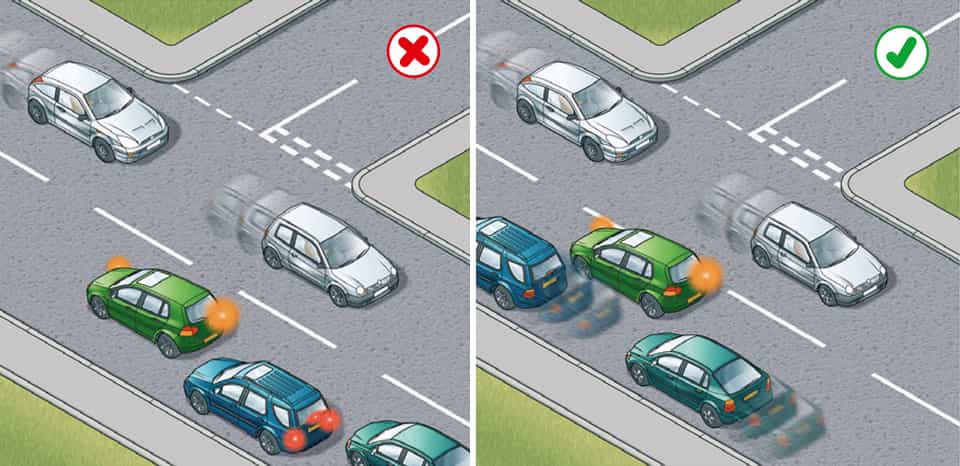
Rule 180: Position your vehicle correctly to avoid obstructing traffic
Rule 181
When turning right at crossroads where an oncoming vehicle is also turning right, there is a choice of two methods
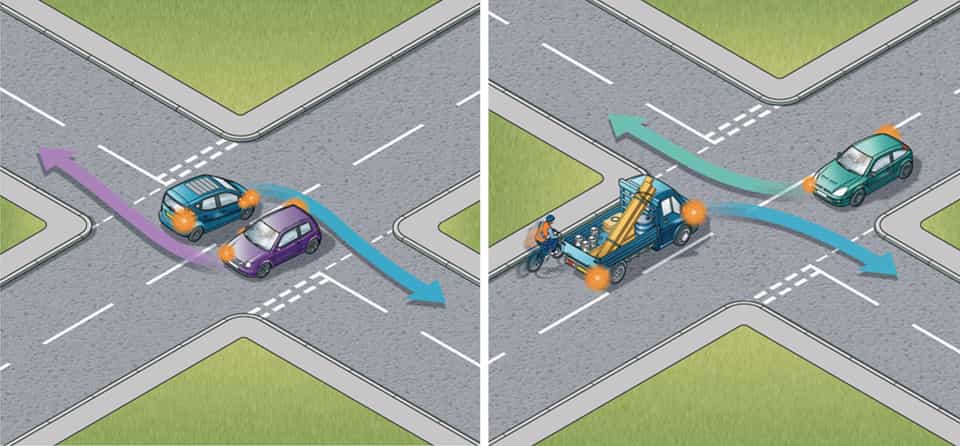
Rule 181: Left - Turning right side to right side. Right - Turning left side to left side
Turning left
Rule 182
Use your mirrors and give a left-turn signal well before you turn left. Do not overtake just before you turn left and watch out for traffic coming up on your left before you make the turn, especially if driving a large vehicle. Cyclists, motorcyclists and other road users in particular may be hidden from your view.
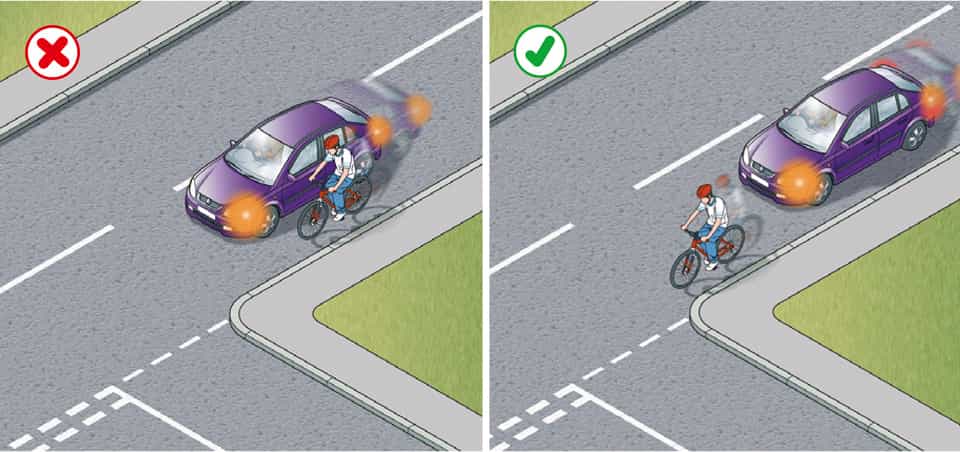
Rule 182: Do not cut in on cyclists
Rule 183
When turning
Rule 184
On approaching a roundabout take notice and act on all the information available to you, including traffic signs, traffic lights and lane markings which direct you into the correct lane. You should
Rule 185
When reaching the roundabout you should
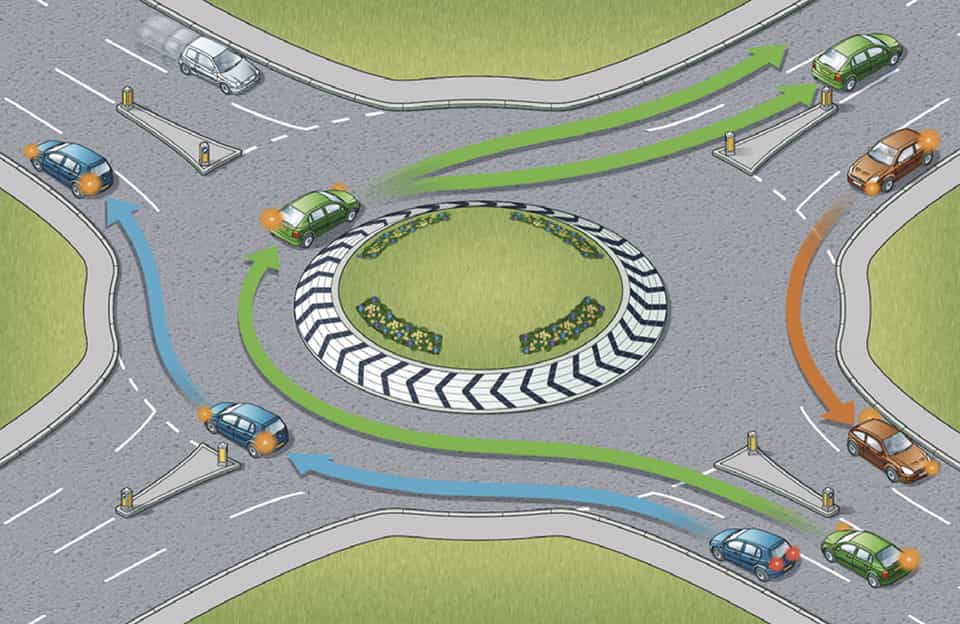
Rule 185: Follow the correct procedure at roundabouts
Rule 186
Signals and position. When taking the first exit to the left, unless signs or markings indicate otherwise
When taking an exit to the right or going full circle, unless signs or markings indicate otherwise
When taking any intermediate exit, unless signs or markings indicate otherwise
When there are more than three lanes at the entrance to a roundabout, use the most appropriate lane on approach and through it.
You should give priority to cyclists on the roundabout. They will be travelling more slowly than motorised traffic. Give them plenty of room and do not attempt to overtake them within their lane. Allow them to move across your path as they travel around the roundabout.
Cyclists, horse riders and horse drawn vehicles may stay in the left-hand lane when they intend to continue across or around the roundabout and should signal right to show you they are not leaving the roundabout. Drivers should take extra care when entering a roundabout to ensure that they do not cut across cyclists, horse riders or horse drawn vehicles in the left-hand lane, who are continuing around the roundabout.
Rule 187
In all cases watch out for and give plenty of room to
Rule 188
Mini-roundabouts. Approach these in the same way as normal roundabouts. All vehicles MUST pass round the central markings except large vehicles which are physically incapable of doing so. Remember, there is less space to manoeuvre and less time to signal. Avoid making U-turns at mini-roundabouts. Beware of others doing this.
Laws RTA 1988 sect 36 & TSRGD schedule 9 parts 7 and 8
Rule 189
At double mini-roundabouts treat each roundabout separately and give way to traffic from the right.
Rule 190
Multiple roundabouts. At some complex junctions, there may be a series of mini-roundabouts at each intersection. Treat each mini-roundabout separately and follow the normal rules.
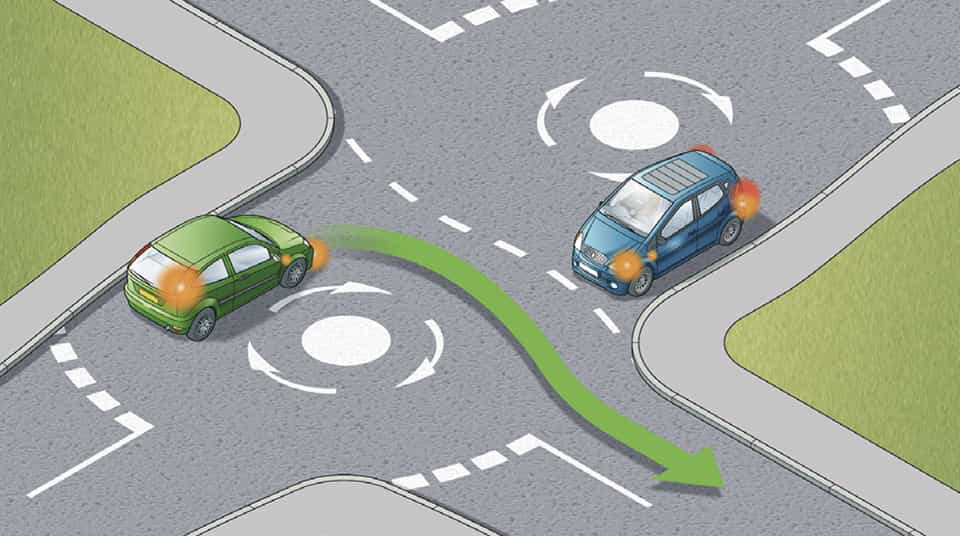
Rule 190: Treat each roundabout separately
Rule 191
You MUST NOT park on a crossing or in the area covered by the zig-zag lines. You MUST NOT overtake the moving vehicle nearest the crossing or the vehicle nearest the crossing which has stopped to give way to pedestrians.
Laws RTRA sect 25(5) & TSRGD schedule 14 parts 1 and 5
Rule 192
In slow-moving and queuing traffic you should keep crossings completely clear, as blocking these makes it difficult and dangerous for pedestrians to cross. You should not enter a pedestrian crossing if you are unable to completely clear the crossing. Nor should you block advanced stop lines for cycles.
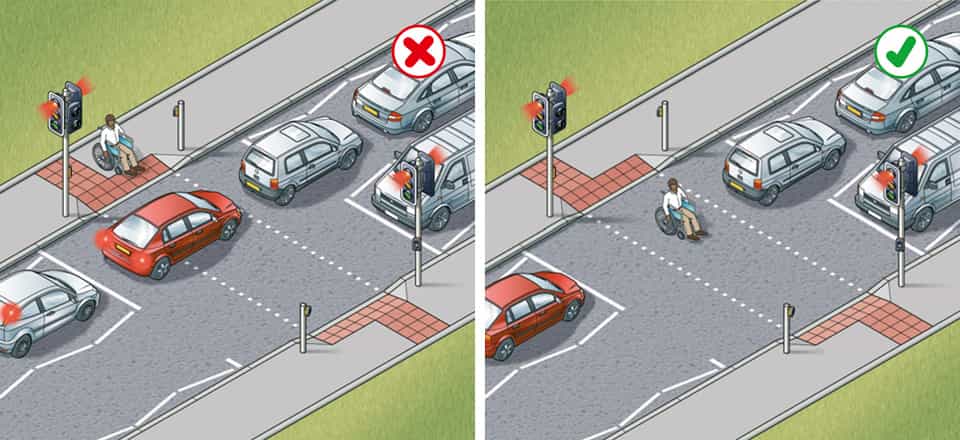
Rule 192: Keep the crossing clear
Rule 193
You should take extra care where the view of either side of the crossing is blocked by queuing traffic or incorrectly parked vehicles. Pedestrians may be crossing between stationary vehicles.
Rule 194
Allow pedestrians plenty of time to cross and do not harass them by revving your engine or edging forward.
Rule 195
Zebra and parallel crossings. As you approach a zebra crossing
A zebra crossing with a central island is two separate crossings (see Rules 19 and 20).
Parallel crossings are similar to zebra crossings, but include a cycle route alongside the black and white stripes.
As you approach a parallel crossing
A parallel crossing with a central island is two separate crossings (see Rules 19 and 20).
Law TSRGD schedule 14 part 5
Signal-controlled crossings
Rule 196
Pelican crossings. These are signal-controlled crossings where flashing amber follows the red ‘Stop’ light. You MUST stop when the red light shows. When the amber light is flashing, you MUST give way to any pedestrians on the crossing. If the amber light is flashing and there are no pedestrians on the crossing, you may proceed with caution.
Laws TSRGD reg 14 & RTRA sect 25(5)
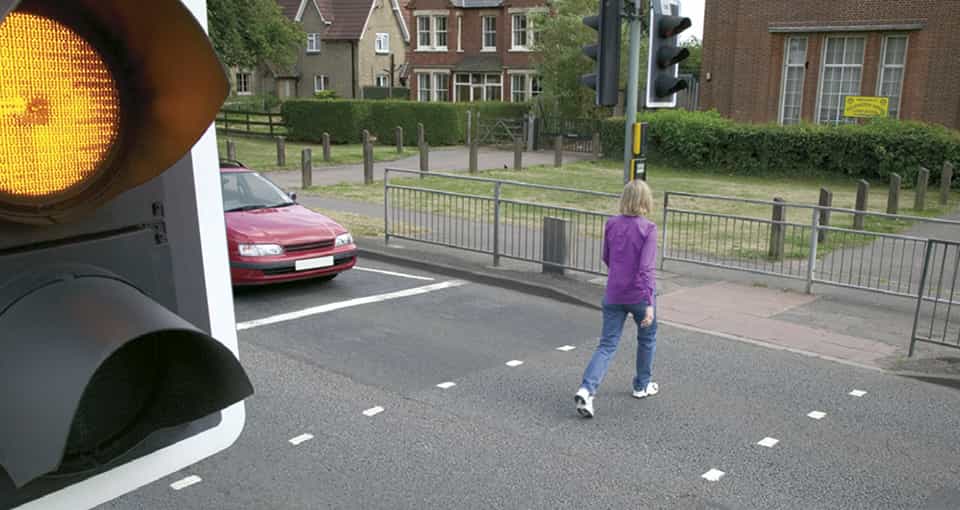
Rule 196: Allow pedestrians to cross when the amber light is flashing
Rule 197
Pelican crossings which go straight across the road are one crossing, even when there is a central island. You MUST wait for pedestrians who are crossing from the other side of the island.
Law TSRGD reg 14
Rule 198
Give way to anyone still crossing after the signal for vehicles has changed to green. This advice applies to all crossings.
Rule 199
Toucan, puffin and equestrian crossings. These are similar to pelican crossings, but there is no flashing amber phase; the light sequence for traffic at these three crossings is the same as at traffic lights. If the signal-controlled crossing is not working, proceed with extreme caution. Do not enter the crossing if you are unable to completely clear it, to avoid obstructing pedestrians, cyclists or horse riders.
Rule 200
Choose an appropriate place to manoeuvre. If you need to turn your vehicle around, wait until you find a safe place. Try not to reverse or turn round in a busy road; find a quiet side road or drive round a block of side streets.
Rule 201
Do not reverse from a side road into a main road. When using a driveway, reverse in and drive out if you can.
Rule 202
Look carefully before you start reversing. You should
Reverse slowly while
Get someone to guide you if you cannot see clearly.
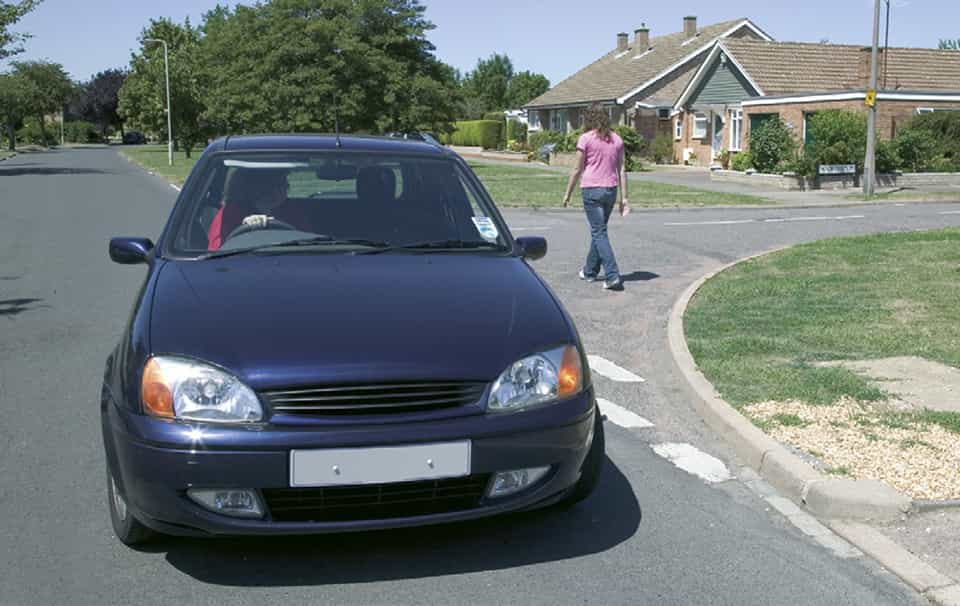
Rule 202: Check all round when reversing
Rule 203
You MUST NOT reverse your vehicle further than necessary.
Law CUR reg 106

Rule 204
The road users most at risk from road traffic are pedestrians, in particular children, older adults and disabled people, cyclists, horse riders and motorcyclists. It is particularly important to be aware of children, older adults and disabled people, and learner and inexperienced drivers and riders. In any inter
Rule 204
The road users most at risk from road traffic are pedestrians, in particular children, older adults and disabled people, cyclists, horse riders and motorcyclists. It is particularly important to be aware of children, older adults and disabled people, and learner and inexperienced drivers and riders. In any interaction between road users, those who can cause the greatest harm have the greatest responsibility to reduce the danger or threat they pose to others.
Rule 205
There is a risk of pedestrians, especially children, stepping unexpectedly into the road. You should drive with the safety of children in mind at a speed suitable for the conditions.
Rule 206
Drive carefully and slowly when
Law TSRGD schedule 14 Part 5
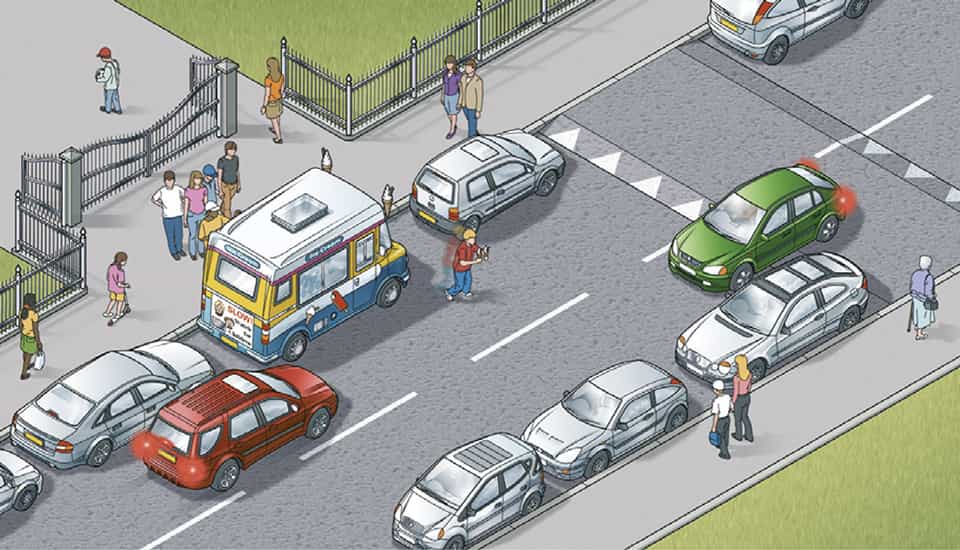
Rule 206: Watch out for children in busy areas
Rule 207
Particularly vulnerable pedestrians. These include:
Rule 208
Near schools. Drive slowly and be particularly aware of young cyclists and pedestrians. In some places, there may be a flashing amber signal below the ‘School’ warning sign which tells you that there may be children crossing the road ahead. Drive very slowly until you are clear of the area.
Rule 209
Drive carefully and slowly when passing a stationary bus showing a ‘School Bus’ sign as children may be getting on or off.
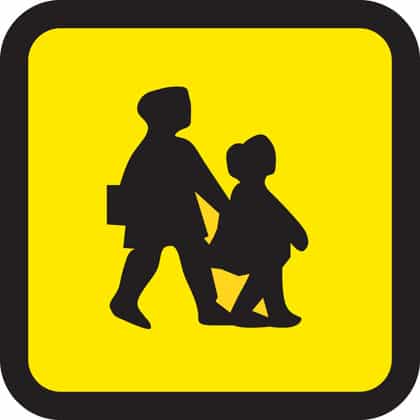
School bus (displayed in front and rear window of bus or coach)
Rule 210
You MUST stop when a school crossing patrol shows a ‘Stop for children’ sign (see ‘Signals by authorised persons’ and ‘Traffic signs’).
Law RTRA sect 28
Rule 211
It is often difficult to see motorcyclists and cyclists, especially when they are waiting alongside you, coming up from behind, coming out of or moving off from junctions, at roundabouts, overtaking you or filtering through traffic. Always look out for them before you emerge from a junction; they could be approaching faster than you think.
Do not turn at a junction if to do so would cause the cyclist going straight ahead to stop or swerve, just as you would do with a motor vehicle.
When turning right across a line of slow-moving or stationary traffic, look out for and give way to cyclists or motorcyclists on the inside of the traffic you are crossing. Be especially careful when moving off, turning, and when changing direction or lane. Be sure to check mirrors and blind spots carefully.
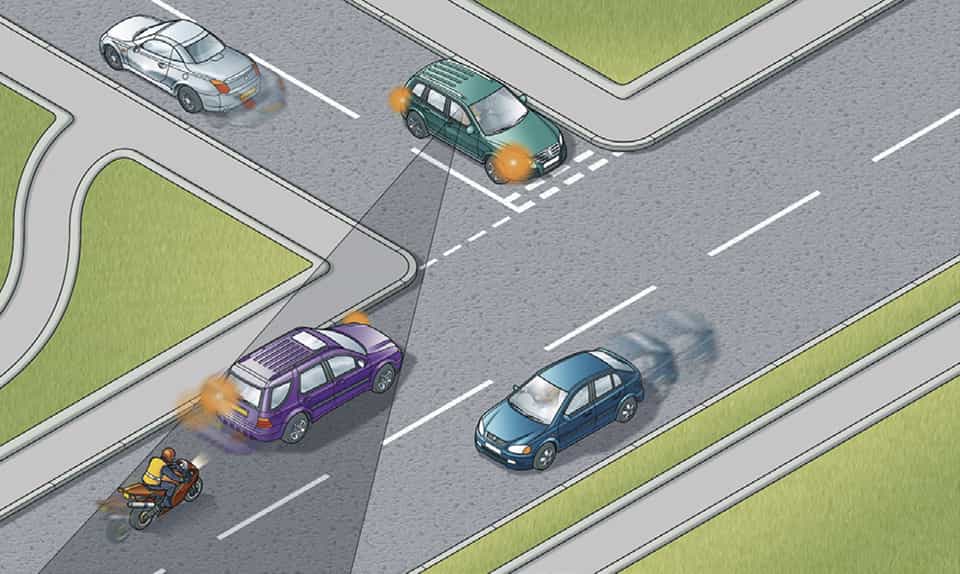
Rule 211: Look out for motorcyclists and cyclists at junctions
Rule 212
Give motorcyclists, cyclists, horse riders, horse drawn vehicles and pedestrians walking in the road (for example, where there is no pavement), at least as much room as you would when overtaking a car (see Rules 162 to 167). Drivers should take extra care and give more space when overtaking motorcyclists, cyclists, horse riders, horse drawn vehicles and pedestrians in bad weather (including high winds) and at night. If the rider looks over their shoulder it could mean that they intend to pull out, turn right or change direction. Give them time and space to do so.
Rule 213
On narrow sections of road, on quiet roads or streets, at road junctions and in slower-moving traffic, cyclists may sometimes ride in the centre of the lane, rather than towards the side of the road. It can be safer for groups of cyclists to ride two abreast in these situations. Allow them to do so for their own safety, to ensure they can see and be seen. Cyclists are also advised to ride at least a door’s width or 1 metre from parked cars for their own safety.
On narrow sections of road, horse riders may ride in the centre of the lane. Allow them to do so for their own safety to ensure they can see and be seen.
Motorcyclists, cyclists, horse riders and horse drawn vehicles may suddenly need to avoid uneven road surfaces and obstacles such as drain covers or oily, wet or icy patches on the road. Give them plenty of room and pay particular attention to any sudden change of direction they may have to make.
Rule 214
Animals. When passing animals, drive slowly. Give them plenty of room and be ready to stop. Do not scare animals by sounding your horn, revving your engine or accelerating rapidly once you have passed them. Look out for animals being led, driven or ridden on the road and take extra care. Keep your speed down at bends and on narrow country roads. If a road is blocked by a herd of animals, stop and switch off your engine until they have left the road. Watch out for animals on unfenced roads.
Rule 215
Horse riders and horse-drawn vehicles. Be particularly careful of horse riders and horse-drawn vehicles especially when approaching, overtaking, passing or moving away. Always pass wide and slowly. When you see a horse on a road, you should slow down to a maximum of 10 mph. Be patient, do not sound your horn or rev your engine. When safe to do so, pass wide and slow, allowing at least 2 metres of space.
Feral or semi feral ponies found in areas such as the New Forest, Exmoor and Dartmoor require the same consideration as ridden horses when approaching or passing.
Horse riders are often children, so take extra care and remember riders may ride in double file when escorting a young or inexperienced horse or rider. Look out for horse riders’ and horse drivers’ signals and heed a request to slow down or stop. Take great care and treat all horses as a potential hazard; they can be unpredictable, despite the efforts of their rider/driver. Remember there are three brains at work when you pass a horse; the rider’s, the driver’s and the horse’s. Do not forget horses are flight animals and can move incredibly quickly if startled.
Rule 216
Older drivers. Their reactions may be slower than other drivers. Make allowance for this.
Rule 217
Learners and inexperienced drivers. They may not be so skilful at anticipating and responding to events. Be particularly patient with learner drivers and young drivers. Drivers who have recently passed their test may display a ‘new driver’ plate or sticker (see ‘Safety code for new drivers’).
Rule 218
Home Zones and Quiet Lanes. These are places where people could be using the whole of the road for a range of activities such as children playing or for a community event. You should drive slowly and carefully and be prepared to stop to allow people extra time to make space for you to pass them in safety.
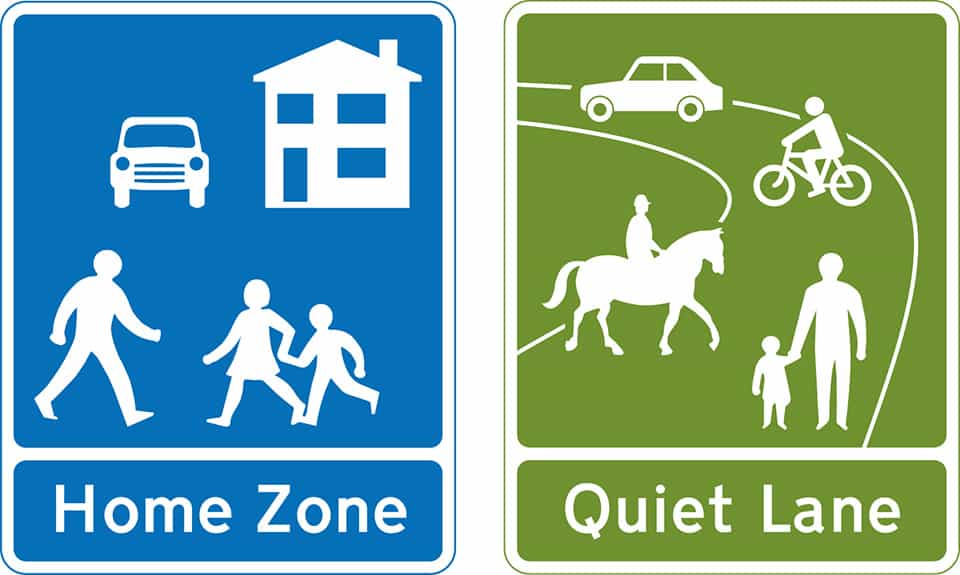
Rule 219
Emergency and Incident Support vehicles. You should look and listen for ambulances, fire engines, police, doctors or other emergency vehicles using flashing blue, red or green lights and sirens or flashing headlights, or traffic officer and incident support vehicles using flashing amber lights. When one approaches do not panic. Consider the route of such a vehicle and take appropriate action to let it pass, while complying with all traffic signs. If necessary, pull to the side of the road and stop, but try to avoid stopping before the brow of a hill, a bend or narrow section of road. Do not endanger yourself, other road users or pedestrians and avoid mounting the kerb. Do not brake harshly on approach to a junction or roundabout, as a following vehicle may not have the same view as you.
Rule 220
Powered vehicles used by disabled people. These small vehicles travel at a maximum speed of 8 mph (12 km/h). On a dual carriageway where the speed limit exceeds 50 mph (80 km/h) they MUST have a flashing amber beacon, but on other roads you may not have that advance warning (see Rules 36 to 46 inclusive).
Law RVLR regs 17(1) & 26
Rule 221
Large vehicles. These may need extra road space to turn or to deal with a hazard that you are not able to see. If you are following a large vehicle, such as a bus or articulated lorry, be aware that the driver may not be able to see you in the mirrors. Be prepared to stop and wait if it needs room or time to turn.
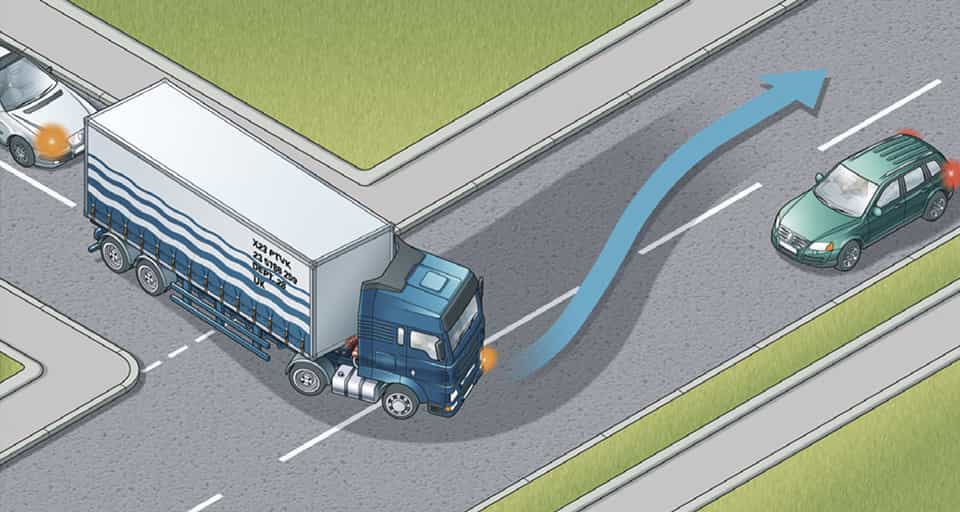
Rule 221: Large vehicles need extra room
Rule 222
Large vehicles can block your view. Your ability to see and to plan ahead will be improved if you pull back to increase your separation distance. Be patient, as larger vehicles are subject to lower speed limits than cars and motorcycles. Many large vehicles may be fitted with speed limiting devices which will restrict speed to 56 mph (90 km/h) even on a motorway.
Rule 223
Buses, coaches and trams. Give priority to these vehicles when you can do so safely, especially when they signal to pull away from stops. Look out for people getting off a bus or tram and crossing the road.
Rule 224
Electric vehicles. Be careful of electric vehicles such as milk floats and trams. Trams move quickly but silently and cannot steer to avoid you.
Rule 225
Vehicles with flashing amber beacons. These warn of a slow-moving or stationary vehicle (such as a traffic officer vehicle, salt spreader, snow plough or recovery vehicle) or abnormal loads, so approach with caution. On unrestricted dual carriageways, motor vehicles first used on or after 1 January 1947 with a maximum speed of 25 mph (40 km/h) or less (such as tractors) MUST use a flashing amber beacon (also see Rule 220).
Law RVLR reg 17

Rule 226
You MUST use headlights when visibility is seriously reduced, generally when you cannot see for more than 100 metres (328 feet). You may also use front or rear fog lights but you MUST switch them off when visibility improves (see Rule 236).
Law RVLR regs 25 & 27
Rule 227
Wet weather. In wet we
Rule 226
You MUST use headlights when visibility is seriously reduced, generally when you cannot see for more than 100 metres (328 feet). You may also use front or rear fog lights but you MUST switch them off when visibility improves (see Rule 236).
Law RVLR regs 25 & 27
Rule 227
Wet weather. In wet weather, stopping distances will be at least double those required for stopping on dry roads (see ‘Typical stopping distances’). This is because your tyres have less grip on the road. In wet weather
Rule 228
In winter check the local weather forecast for warnings of icy or snowy weather. DO NOT drive in these conditions unless your journey is essential. If it is, take great care and allow more time for your journey. Take an emergency kit of de-icer and ice scraper, torch, warm clothing and boots, first aid kit, jump leads and a shovel, together with a warm drink and emergency food in case you get stuck or your vehicle breaks down.
Rule 229
Before you set off
Laws CUR reg 30, RVLR reg 23, VERA sect 43 & RV(DRM)R reg 11
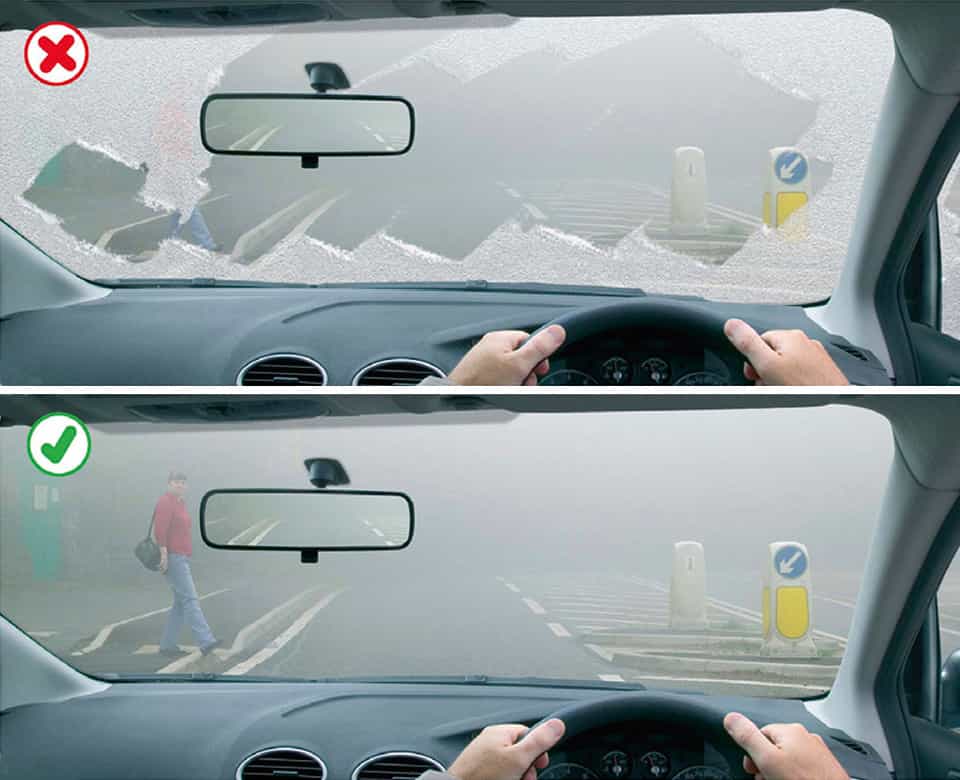
Rule 229: Make sure your windscreen is completely clear
Rule 230
When driving in icy or snowy weather
Rule 231
Drive extremely carefully when the roads are icy. Avoid sudden actions as these could cause loss of control. You should
Rule 232
High-sided vehicles are most affected by windy weather, but strong gusts can also blow a car, cyclist, motorcyclist or horse rider off course. This can happen on open stretches of road exposed to strong crosswinds, or when passing bridges or gaps in hedges.
Rule 233
In very windy weather your vehicle may be affected by turbulence created by large vehicles. Motorcyclists are particularly affected, so keep well back from them when they are overtaking a high-sided vehicle.
Rule 234
Before entering fog check your mirrors then slow down.
If ‘Fog’ is shown on a sign but the road is clear, be prepared for a bank of fog or drifting patchy fog ahead. Even if it seems to be clearing, you can suddenly find yourself in thick fog.
Rule 235
When driving in fog you should
Rule 236
You MUST NOT use front or rear fog lights unless visibility is seriously reduced (see Rule 226) as they dazzle other road users and can obscure your brake lights. You MUST switch them off when visibility improves.
Law RVLR regs 25 & 27
Rule 237
Keep your vehicle well ventilated to avoid drowsiness. Be aware that the road surface may become soft or if it rains after a dry spell it may become slippery. These conditions could affect your steering and braking. If you are dazzled by bright sunlight, slow down and if necessary, stop.

Rule 238
You MUST NOT wait or park on yellow lines during the times of operation shown on nearby time plates (or zone entry signs if in a Controlled Parking Zone) – see ‘Traffic signs’ and ‘Road markings’. Double yellow lines indicate a prohibition of waiting at any time even if there are no upright signs. You MUST NOT wa
Rule 238
You MUST NOT wait or park on yellow lines during the times of operation shown on nearby time plates (or zone entry signs if in a Controlled Parking Zone) – see ‘Traffic signs’ and ‘Road markings’. Double yellow lines indicate a prohibition of waiting at any time even if there are no upright signs. You MUST NOT wait or park, or stop to set down and pick up passengers, on school entrance markings (see ‘Road markings’) when upright signs indicate a prohibition of stopping.
Law RTRA sects 5 & 8
Rule 239
Use off-street parking areas, or bays marked out with white lines on the road as parking places, wherever possible. If you have to stop on the roadside:
Before using a hand-held device to help you to park, you MUST make sure it is safe to do so. Then, you should move the vehicle into the parking space in the safest way, and by the shortest route possible.
When you use a hand-held device to help you to park, you MUST remain in control of the vehicle at all times. Do not use the hand-held device for anything else while you are using it to help you park, and do not put anyone in danger. Use the hand-held device according to the manufacturer’s instructions.
When using an electric vehicle charge point, you should park close to the charge point and avoid creating a trip hazard for pedestrians from trailing cables. Display a warning sign if you can. After using the charge point, you should return charging cables and connectors neatly to minimise the danger to pedestrians and avoid creating an obstacle for other road users.
Laws CUR regs 98, 105, 107 & 110, RVLR reg 27 & RTA 1988 sect 42
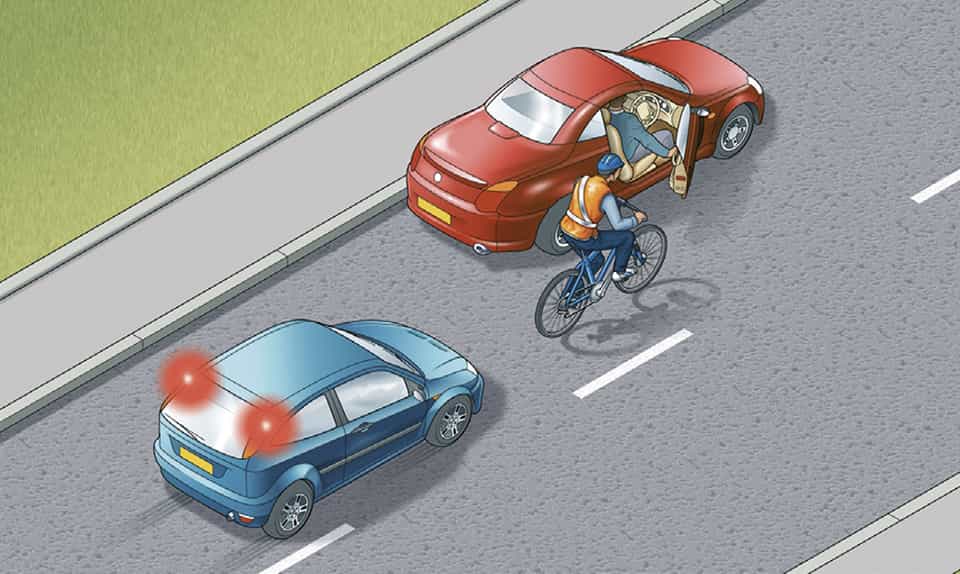
Rule 239: Check before opening your door
Rule 240
You MUST NOT stop or park on
Laws MT(E&W)R regs 7 & 9 as amended by MT(E&W)(A)(E)R, MT(S)R regs 6 & 8, RTRA sects 5, 6 and 8, TSRGD schedule 7 parts 2, 3, 4, 5 and 7, schedule 9 part 6, schedule 14 parts 1 and 5
Rule 241
You MUST NOT park in parking spaces reserved for specific users, such as Blue Badge holders, residents or motorcycles, unless entitled to do so.
Laws CSDPA sect 21 & RTRA sects 5 & 8
Rule 242
You MUST NOT leave your vehicle or trailer in a dangerous position or where it causes any unnecessary obstruction of the road.
Laws RTA 1988 sect 22 & CUR reg 103
Rule 243
DO NOT stop or park:
except when forced to do so by stationary traffic.
Rule 244
You MUST NOT park partially or wholly on the pavement in London, and should not do so elsewhere unless signs permit it. Parking on the pavement can obstruct and seriously inconvenience pedestrians, people in wheelchairs or with visual impairments and people with prams or pushchairs.
Law GL(GP)A sect 15
Rule 245
Controlled Parking Zones. The zone entry signs indicate the times when the waiting restrictions within the zone are in force. Parking may be allowed in some places at other times. Otherwise parking will be within separately signed and marked bays.
Rule 246
Goods vehicles. Vehicles with a maximum laden weight of over 7.5 tonnes (including any trailer) MUST NOT be parked on a verge, pavement or any land situated between carriageways, without police permission. The only exception is when parking is essential for loading and unloading, in which case the vehicle MUST NOT be left unattended.
Law RTA 1988 sect 19
Rule 247
Loading and unloading. Do not load or unload where there are yellow markings on the kerb and upright signs advise restrictions are in place (see ‘Road markings’). This may be permitted where parking is otherwise restricted. On red routes, specially marked and signed bays indicate where and when loading and unloading is permitted.
Law RTRA sects 5 & 8
Rule 248
You MUST NOT park on a road at night facing against the direction of the traffic flow unless in a recognised parking space.
Laws CUR reg 101 & RVLR reg 24
Rule 249
All vehicles MUST display parking lights when parked on a road or a lay-by on a road with a speed limit greater than 30 mph (48 km/h).
Law RVLR reg 24
Rule 250
Cars, goods vehicles not exceeding 2500 kg laden weight, invalid carriages, motorcycles and pedal cycles may be parked without lights on a road (or lay-by) with a speed limit of 30 mph (48 km/h) or less if they are:
Other vehicles and trailers, and all vehicles with projecting loads, MUST NOT be left on a road at night without lights.
Laws RVLR reg 24 & CUR reg 82(7)
Rule 251
Parking in fog. It is especially dangerous to park on the road in fog. If it is unavoidable, leave your parking lights or sidelights on.
Rule 252
Parking on hills. If you park on a hill you should:
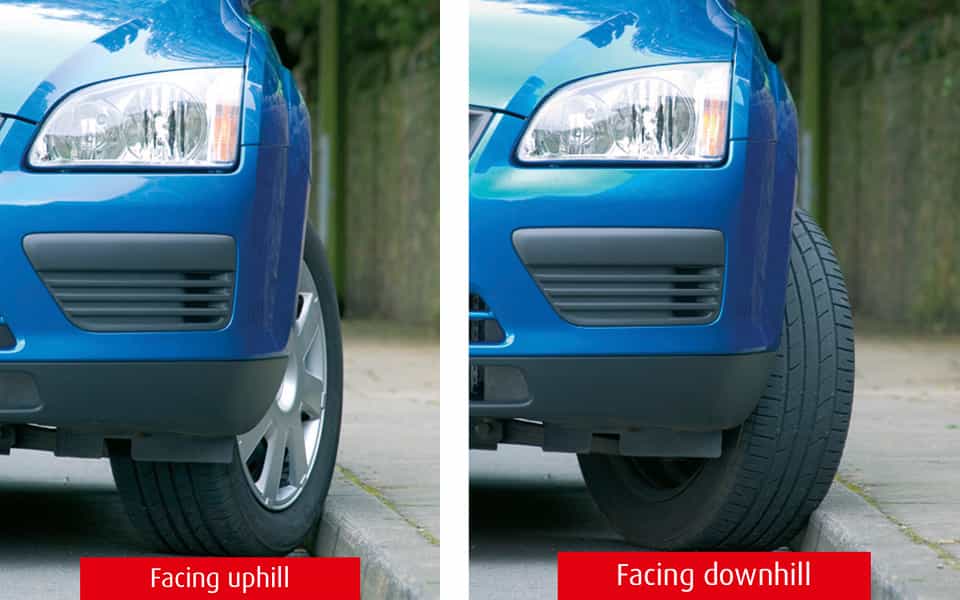
Rule 252: Turn your wheels away from the kerb when parking facing uphill. Turn them towards the kerb when parking facing downhill
DPE is becoming increasingly common as more authorities take on this role. The local traffic authority assumes responsibility for enforcing many parking contraventions in place of the police. Further details on DPE may be found at the following websites:
Traffic Penalty Tribunal (outside London) London Tribunals (inside London)

Rule 253
Prohibited vehicles. Motorways MUST NOT be used by pedestrians, holders of provisional motorcycle licences, riders of motorcycles under 50 cc (4 kW), cyclists, horse riders, certain slow-moving vehicles and those carrying oversized loads (except by special permission), agricultural vehicles, and powered w
Rule 253
Prohibited vehicles. Motorways MUST NOT be used by pedestrians, holders of provisional motorcycle licences, riders of motorcycles under 50 cc (4 kW), cyclists, horse riders, certain slow-moving vehicles and those carrying oversized loads (except by special permission), agricultural vehicles, and powered wheelchairs/powered mobility scooters (see Rules 36 to 46 inclusive).
Provisional car licence holders MUST NOT drive on the motorway unless they are accompanied by a DVSA Approved Driving Instructor (ADI) and are driving a car displaying red L plates (or D plates in Wales) with dual controls.
Laws HA 1980 sects 16, 17 & sched 4, MT(E&W)R regs 3(d), 4 & 11 as amended by MT(E&W)(A)R 2004 & MT(E&W)(A)R 2018, R(S)A sects 7, 8 & sched 3, RTRA sect 17 & MT(S)R reg 10 as amended by MT(S)(A)R 2018
Rule 254
Traffic on motorways usually travels faster than on other roads, so you have less time to react. It is especially important to use your mirrors earlier and look much further ahead than you would on other roads.
Rule 255
Signs and signals (see ‘Light signals controlling traffic’) are used to warn you of hazards ahead. For example, there may be an incident, fog, a spillage or road workers on the carriageway which you may not immediately be able to see.
Rule 256
A single sign or signal can display advice, restrictions and warnings for all lanes.

Lane specific signs and signals can display advice, restrictions and warnings that apply to individual lanes.
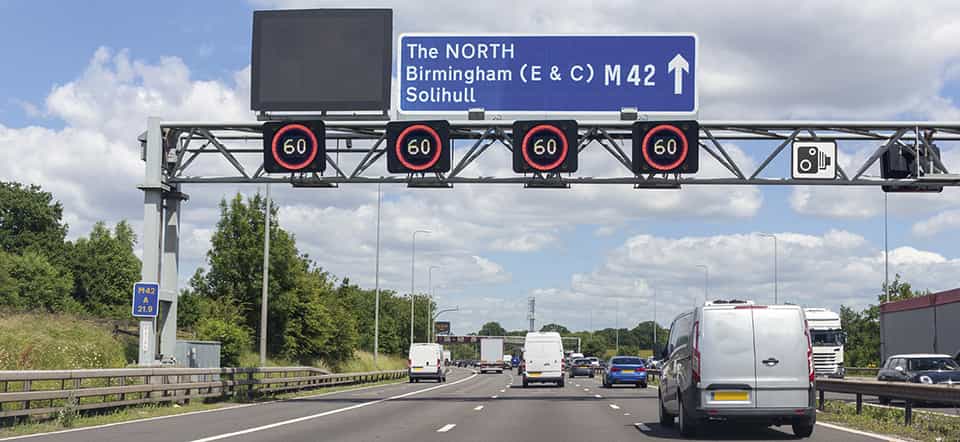
Rule 257
Amber flashing lights. These signals warn of a hazard ahead. You should
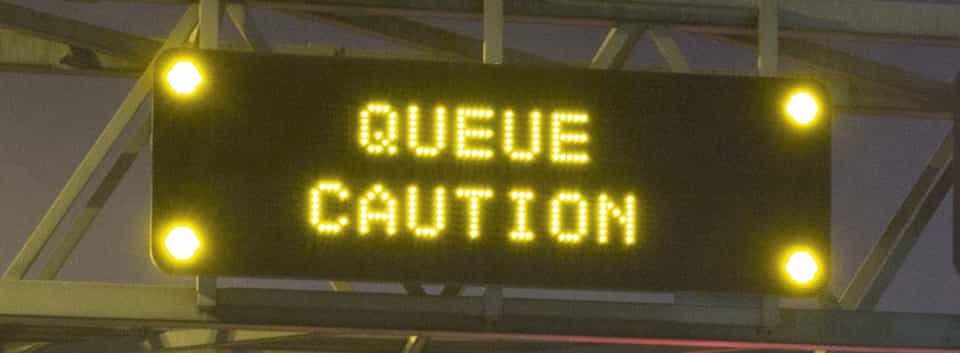
Rule 257: Signal warning of a hazard
Rule 258
Red flashing light signals and a red ‘X’ on a sign identify a closed lane in which people, stopped vehicles or other hazards are present. You
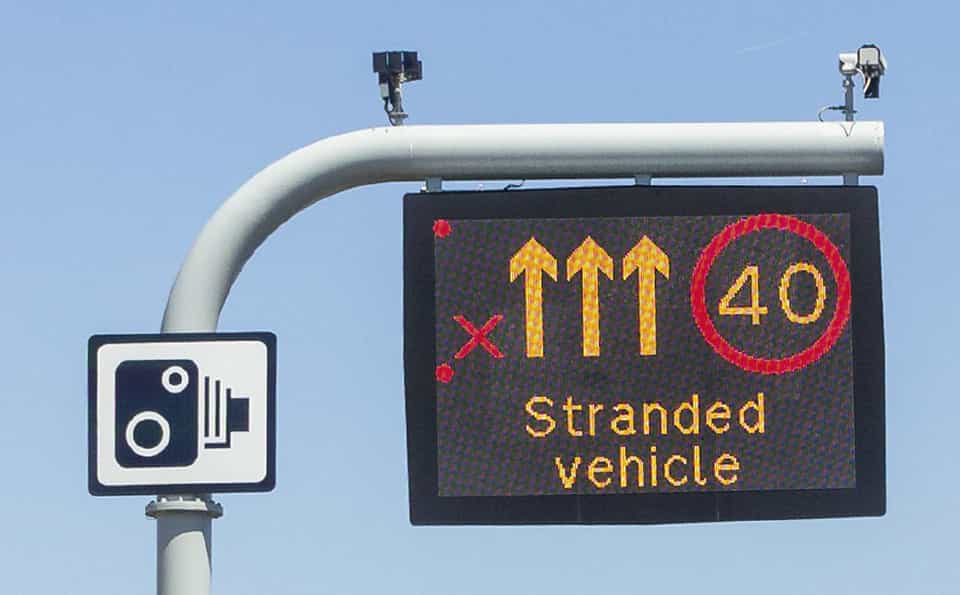
Rule 258: signals and signs indicating lane closures
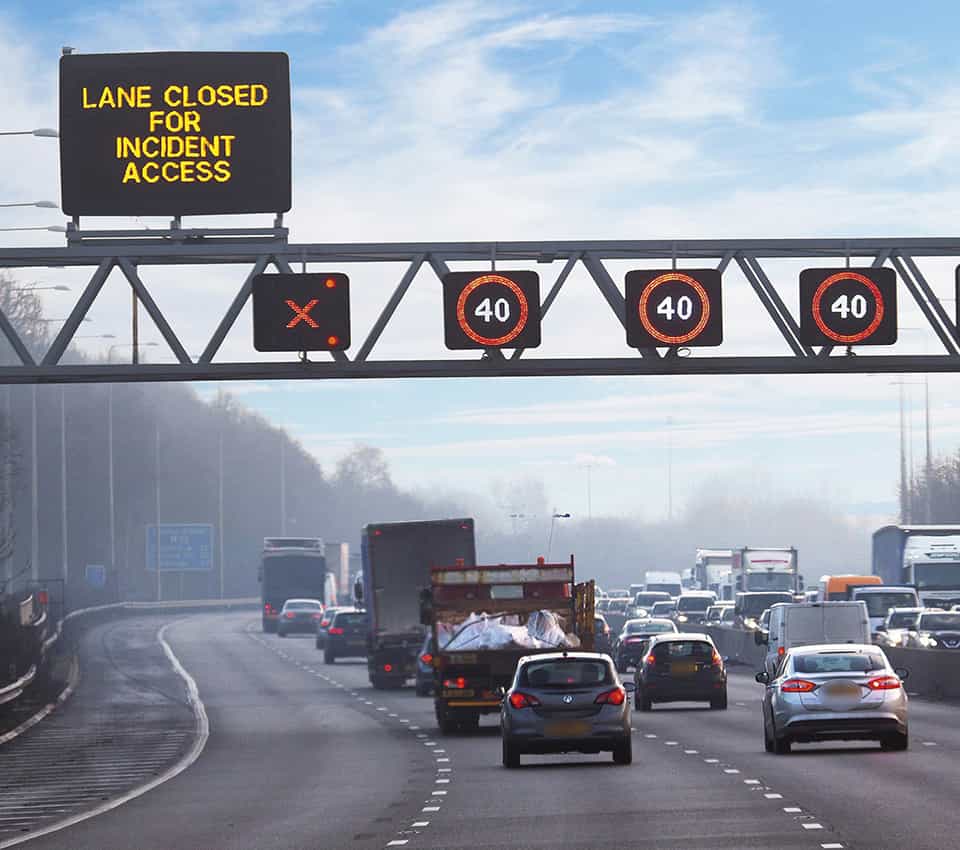
Rule 258: signals and signs indicating lane closures
Be aware that
Where red flashing light signals and closure of all lanes are shown on a sign, the road is closed. You
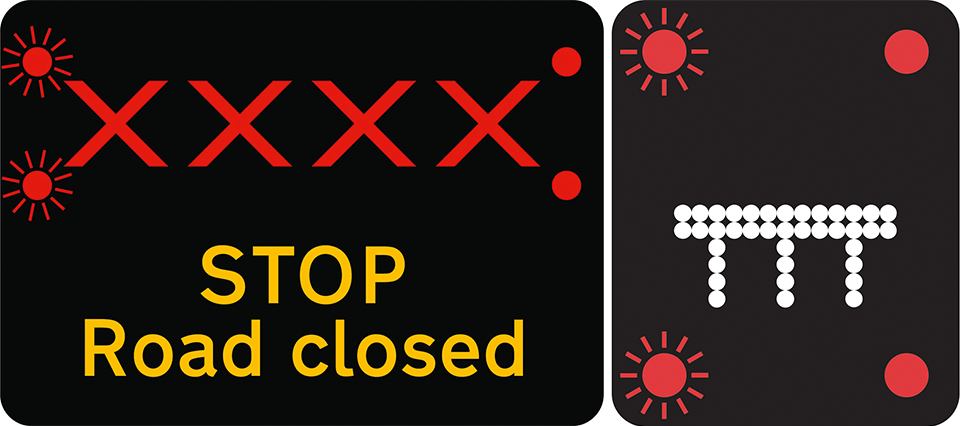
Rule 258: signals and signs indicating lane closures
Lane and road closures indicated by red flashing lights are enforced by the police.
Laws RTA 1988 sects 35 & 36 as amended by TMA sect 6, TSRGD reg 3 and sched 15, MT(E&W)R reg 9 & MT(S)R reg 8.
Rule 259
Joining the motorway. When you join the motorway you will normally approach it from a road on the left (a slip road) or from an adjoining motorway. You should
Rule 260
When you can see well ahead and the road conditions are good, you should
Rule 261
You MUST NOT exceed
Speed limits are enforced by the police (see Rule 124).
Law RTRA sects 17, 86, 89 & sched 6
Rule 262
The monotony of driving on motorways and other high-speed roads can make you feel sleepy. To minimise the risk, follow the advice in Rule 91 about ensuring you are fit to drive and taking breaks.
Service areas are located along motorways to allow you to take breaks and to obtain refreshments. Refreshment and rest facilities on the local road network may also be accessible from motorway exits.
Rule 263
Unless directed to do so by a police or traffic officer, you MUST NOT
If you have missed your exit, or have taken the wrong route, carry on to the next exit.
Laws RTA 1988 sect 35 as amended by TMA sect 6, MT(E&W)R regs 6, 8 & 10, & MT(S)R regs 4, 5, 7 & 9
Rule 264
Keep in the left lane unless overtaking.
Rule 265
The right-hand lane of a motorway with three or more lanes MUST NOT be used (except in prescribed circumstances) if you are driving
Laws MT(E&W)R reg 12, MT(E&W)(A)R, MT(S)R reg 11 & MT(S)(A)R
Rule 266
Approaching a junction. Look well ahead for signals, signs and road markings. Direction signs may be placed over the road. If you need to, you should change lanes well ahead of a junction. At some junctions, a lane may lead directly off the road. Only get in that lane if you wish to go in the direction indicated by signs or road markings.
Rule 267
Do not overtake unless you are sure it is safe and legal to do so. Overtake only on the right. You should
Rule 268
Do not overtake on the left or move to a lane on your left to overtake. In congested conditions, where adjacent lanes of traffic are moving at similar speeds, traffic in left-hand lanes may sometimes be moving faster than traffic to the right. In these conditions you may keep up with the traffic in your lane even if this means passing traffic in the lane to your right. Do not weave in and out of lanes to overtake.
Rule 269
Hard shoulder (where present). You MUST NOT use a hard shoulder except in an emergency or if directed to do so by the police, traffic officers or a traffic sign.
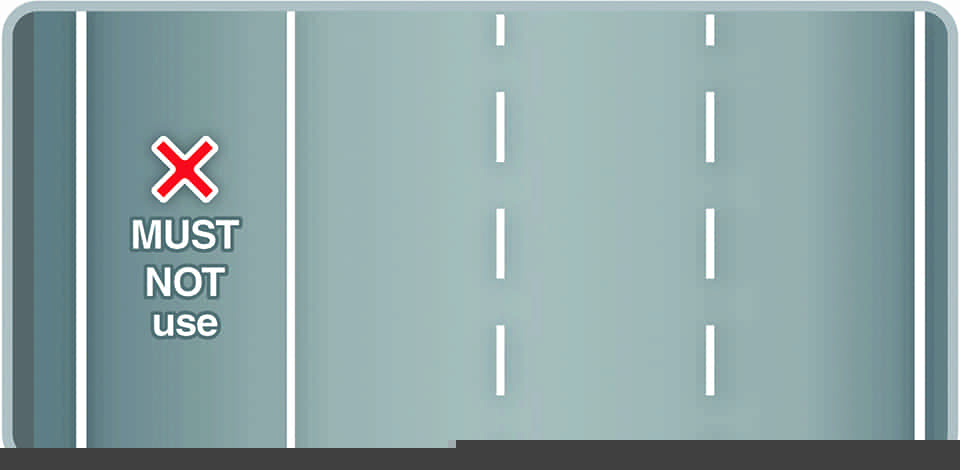
Hard shoulder (where used as an extra lane). The hard shoulder is used as an extra lane on some motorways during periods of congestion. A red ‘X’ or blank sign above the hard shoulder means that you MUST NOT use the hard shoulder except in an emergency.

You can only use the hard shoulder as an extra lane when a speed limit is shown above the hard shoulder.
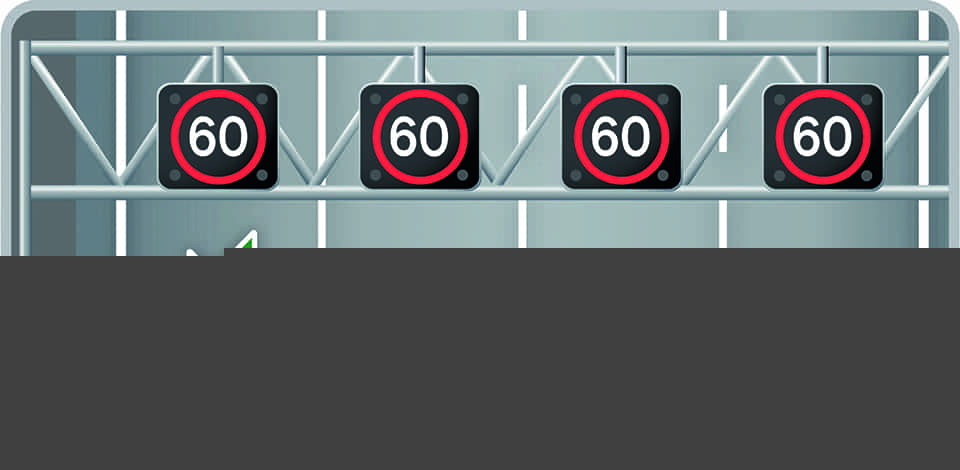
Where the hard shoulder is being used as an extra lane, emergency areas are provided for use in an emergency (see Rule 270).
Laws MT(E&W)R regs 5 & 9, MT(S)R regs 4 & 8, & RTA 1988 sects 35 & 36 as amended by TMA sect 6
Rule 270
Emergency areas are located along motorways with no hard shoulder or where the hard shoulder can be used as an extra lane (see Rule 269) and MUST only be used in an emergency.
They are marked by blue signs with an orange SOS telephone symbol and may have orange surfacing.
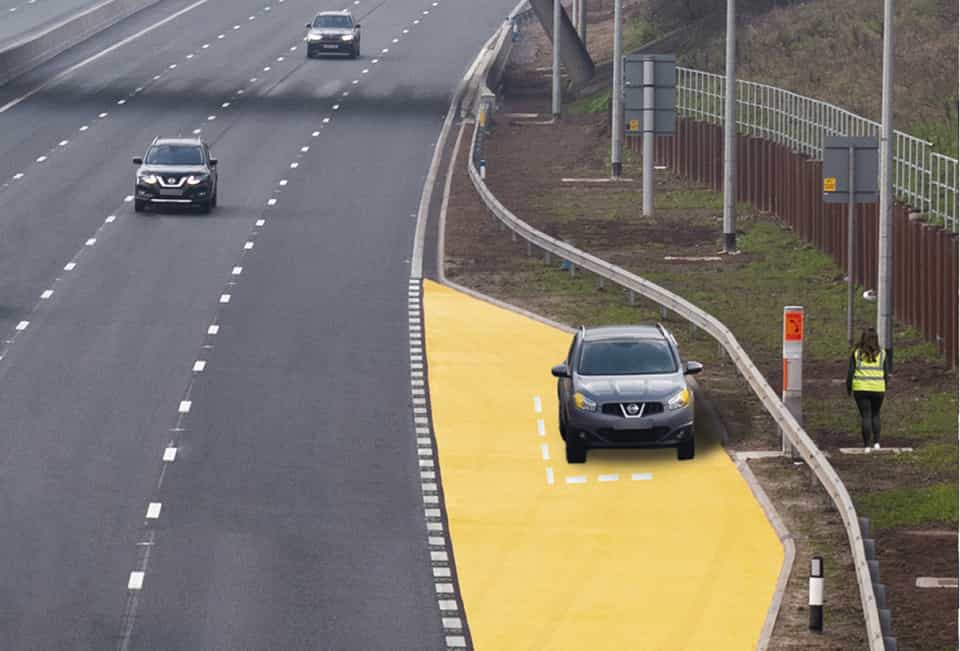
Rule 270: emergency area
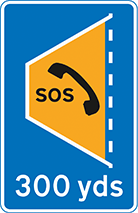
Rule 270: sign indicating distance to next emergency area
Follow the requirements and advice in
Laws MT(E&W)R reg 9 as amended by MT(E&W)(A)(E)R, & MT(S)R reg 8
Rule 271
You MUST NOT stop on any carriageway, emergency area, hard shoulder, slip road, central reservation or verge except in an emergency, or when told to do so by the police, traffic officers, an emergency sign or by red flashing light signals.
Do not stop on any part of a motorway to make or receive mobile telephone calls, except in an emergency.
Laws MT(E&W)R regs 7, 9, 10 & 16 as amended by MT(E&W)(A)(E)R, MT(S)R regs 6(1), 8, 9 & 14, PRA sect 41 & sched 5(8), RTA 1988 sects 35, 36 & 163 as amended by TMA sect 6, & CUR reg 110 as amended by CUR(A)(No4)R
Rule 272
You MUST NOT pick up or set down anyone, or walk on a motorway, except in an emergency.
Laws RTRA sect 17 & MT(E&W)R reg 15
Rule 273
Unless signs indicate that a lane leads directly off the motorway, you will normally leave the motorway by a slip road on your left. You should
Rule 274
On leaving the motorway or using a link road between motorways, your speed may be higher than you realise - 50 mph may feel like 30 mph. Check your speedometer and adjust your speed accordingly. Some slip-roads and link roads have sharp bends, so you will need to slow down.

Rule 275
If you need to stop your vehicle in the event of a breakdown or incident, try to stop in a place of relative safety. A place of relative safety is where you, your passengers and your vehicle are less likely to be at risk from moving traffic.
The safest place to stop is a location which is designed
Rule 275
If you need to stop your vehicle in the event of a breakdown or incident, try to stop in a place of relative safety. A place of relative safety is where you, your passengers and your vehicle are less likely to be at risk from moving traffic.
The safest place to stop is a location which is designed for parking. On motorways and other high-speed roads, the safest place to stop is a service area. Other places of relative safety include
Be aware that hard shoulders provide less protection than other places of relative safety because they are so close to high-speed traffic.
You and your passengers should, where possible, keep well away from your vehicle and moving traffic. Otherwise moving traffic could collide with your vehicle, forcing it into you and your passengers.
Rule 276
If your vehicle breaks down, think first of all other road users and
Rule 277
If your vehicle develops a problem, leave the carriageway at the next exit or pull into a service area if possible (see Rule 275 for places of relative safety). If you cannot, you should
Go left
Get safe
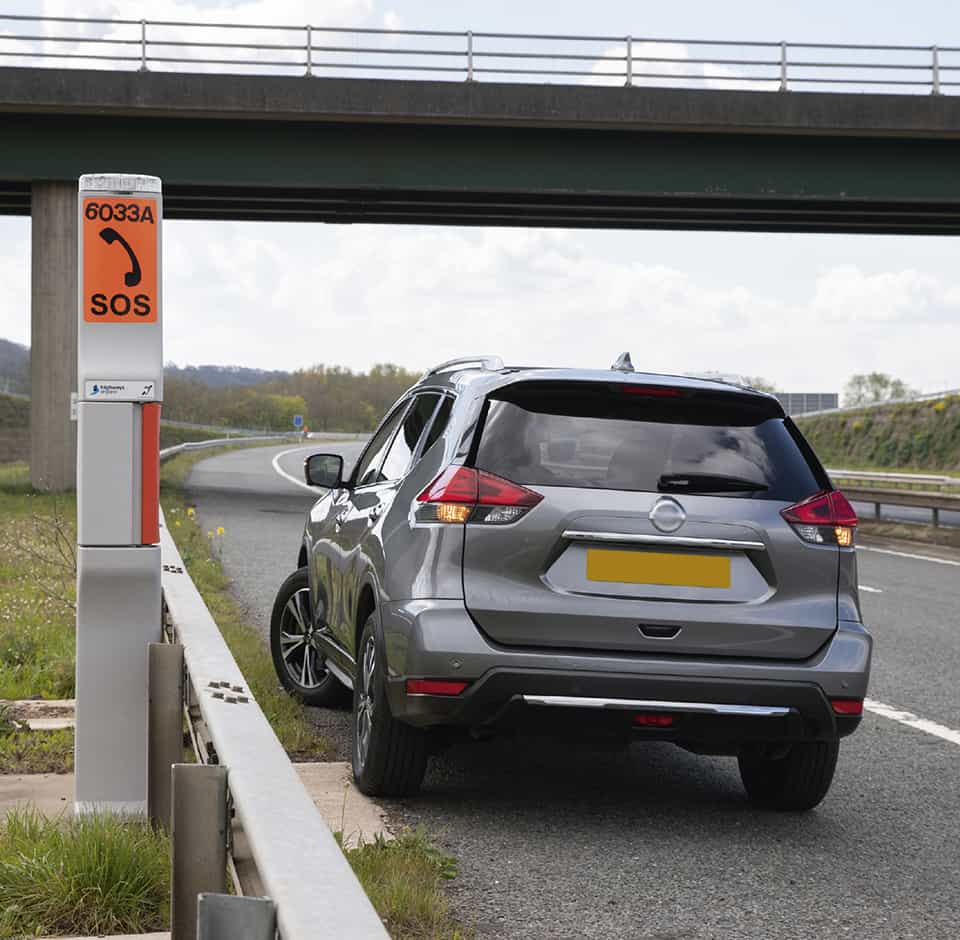
Rule 277: Keep well away from your vehicle and moving traffic
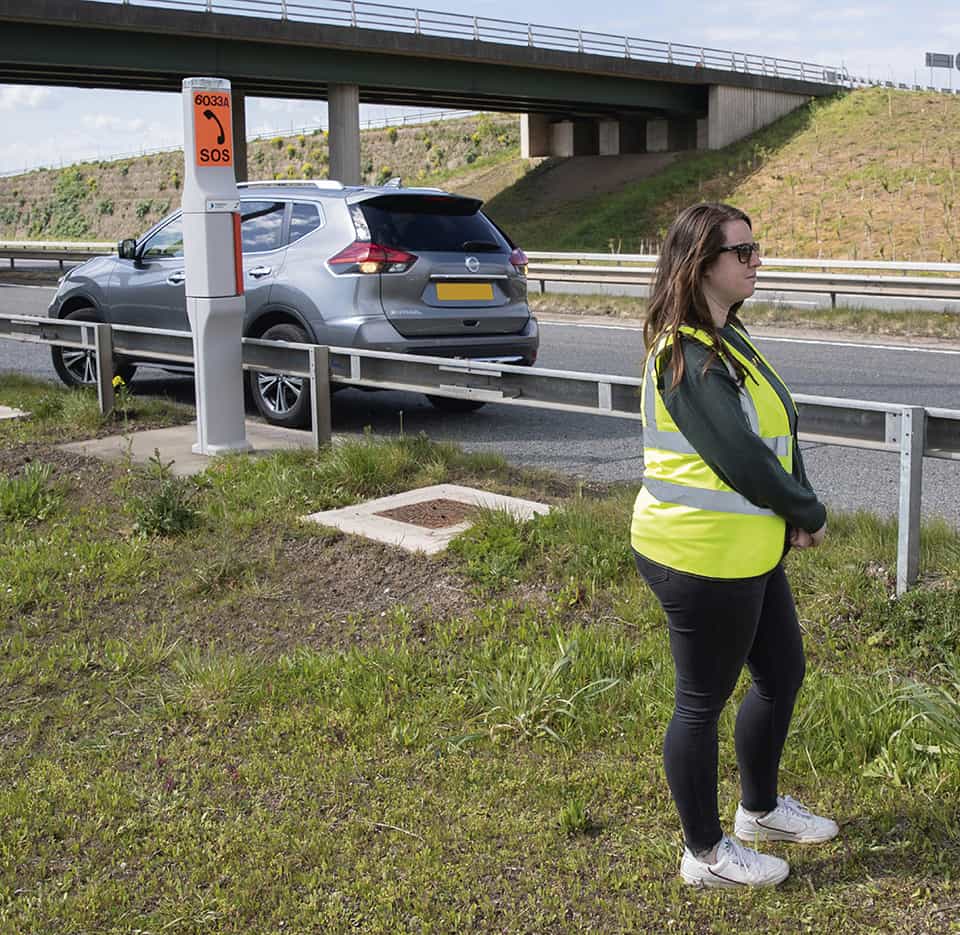
Rule 277: Keep well away from your vehicle and moving traffic
Get help
Communicating your location. How to identify your location to the emergency services.
eCall. Press the SOS button if your vehicle has one. App. Use a mobile telephone mapping application.
App. Use a mobile telephone mapping application.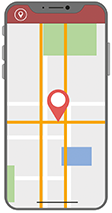 Marker post or driver location sign. Quote the numbers and letters on marker posts or driver location signs which are located along the edge of the road.
Marker post or driver location sign. Quote the numbers and letters on marker posts or driver location signs which are located along the edge of the road.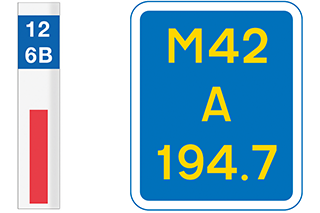
Laws MT(E&W)R reg 14 & MT(S)R reg 12
Rule 278
To rejoin the carriageway after a breakdown from
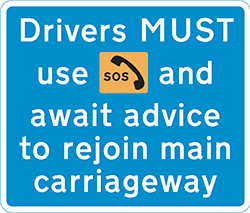
Rule 278: Emergency area information sign
Law RTA 1988 sect 36
Rule 279
Disabled drivers. If you have a disability that prevents you from following the above advice in Rules 277 and 278, you should
If you are deaf, hard of hearing or speech impaired, it is recommended that you register for the 999 text service (emergencySMS.net) before making a journey.
Rule 280
If anything falls from a vehicle on to a motorway or other high-speed road, DO NOT remove the obstruction yourself. Stop in a place of relative safety (see Rule 275) and call the emergency services on 999.
On other roads, you should only remove obstructions if it is safe to do so.
Rule 281
Warning signs or flashing lights. If you see emergency or incident support vehicles displaying flashing lights in the distance, be aware there may be an incident ahead (see Rule 219). You should slow down and be prepared to move safely into another lane or stop.
The emergency services, traffic officers and recovery workers may be required to work in the carriageway; for example, dealing with debris, collisions or conducting rolling roadblocks. You MUST follow any directions given by police or traffic officers as to whether you can safely pass the incident or obstruction.
Laws RTA 1988 sects 35 & 163 as amended by TMA sect 6
Rule 282
When passing the scene of an incident, remain alert for hazards (such as debris or slow-moving vehicles) and do not slow down unnecessarily (for example, if an incident is on the other side of a dual carriageway). You should focus on the road ahead when passing an incident because a lack of attention may cause a further incident, collision or congestion (see also Rule 283, below).
Rule 283
If you are involved in an incident or collision or stop to give assistance
If you are involved in any other medical emergency, you should contact the emergency services in the same way.
Rule 284
Vehicles carrying dangerous goods in packages will be marked with plain orange reflective plates. Road tankers and vehicles carrying tank containers of dangerous goods will have hazard warning plates (see ‘Vehicle markings’).
Rule 285
If an incident involves a vehicle containing dangerous goods, follow the advice in Rule 283 and, in particular
Rule 286
If you are involved in a collision which causes damage or injury to any other person, vehicle, animal or property, you MUST
Law RTA 1988 sect 170
Rule 287
If another person is injured and you do not produce your insurance certificate at the time of the crash to a police officer or to anyone having reasonable grounds to request it, you MUST
Law RTA 1988 sect 170

Rule 288
When the ‘Road Works Ahead’ sign is displayed, take extra care and look for additional signs providing more specific instructions. Observe all signs – they are there for your safety and the safety of road workers.
Rule 288
When the ‘Road Works Ahead’ sign is displayed, take extra care and look for additional signs providing more specific instructions. Observe all signs – they are there for your safety and the safety of road workers.
Law RTRA sect 16
Rule 289
Take special care on motorways and other high-speed dual carriageways.
Laws RTA 1988 sect 36, TSRGD reg 3 and sched 13
Rule 290
Road works may contain features that require extra care.
Rule 291
A level crossing is where a road crosses a railway or tramway line. Approach and cross it with care. Never drive onto a crossing until the road is clear on the other side and do not get too close to the car in front. Never stop or park on, or near, a crossing.
Rule 292
Overhead electric lines. It is dangerous to touch overhead electric lines. You MUST obey the safe height warning road signs and you should not continue forward onto the railway if your vehicle touches any height barrier or bells. The clearance available is usually 5 metres (16 feet 6 inches) but may be lower.
Laws RTA 1988 sect 36 & TSRGD schedule 2 part 7
Rule 293
Controlled Crossings. Most crossings have traffic light signals with a steady amber light, twin flashing red stop lights (see ‘Light signals controlling traffic’ and ‘Traffic signs’) and an audible alarm for pedestrians. They may have full, half or no barriers.
Laws RTA 1988 sect 36 & TSRGD schedule 14 parts 1 and 4
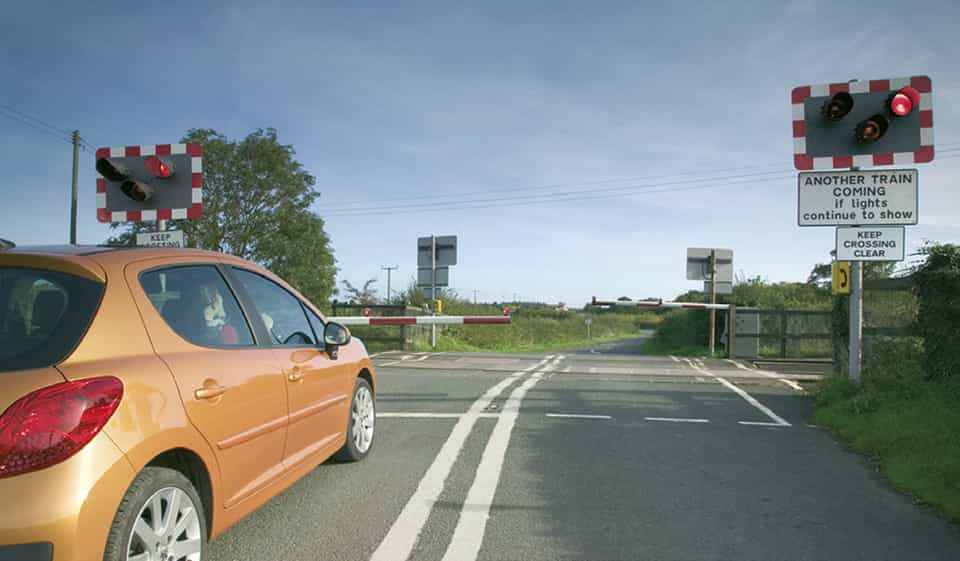
Rule 293: Stop when the traffic lights show
Rule 294
Railway telephones. If you are driving a large or slow- moving vehicle, a long, low vehicle with a risk of grounding, or herding animals, a train could arrive before you are clear of the crossing. You MUST obey any sign instructing you to use the railway telephone to obtain permission to cross. You MUST also telephone when clear of the crossing if requested to do so.
Laws RTA 1988 sect 36 & TSRGD schedule 9 parts 7 and 8
Rule 295
Crossings without traffic lights. Vehicles should stop and wait at the barrier or gate when it begins to close and not cross until the barrier or gate opens.
Rule 296
User-operated gates or barriers. Some crossings have ‘Stop’ signs and small red and green lights. You MUST NOT cross when the red light is showing, only cross if the green light is on. If crossing with a vehicle, you should
Laws TWA 1992 sect 55 & PC(SB)R 1996
Rule 297
If there are no lights, follow the procedure in Rule 296. Stop, look both ways and listen before you cross. If there is a railway telephone, always use it to contact the signal operator to make sure it is safe to cross. Inform the signal operator again when you are clear of the crossing.
Rule 298
Open crossings. These have no gates, barriers, attendant or traffic lights but will have a ‘Give Way’ sign. You should look both ways, listen and make sure there is no train coming before you cross.
Rule 299
Incidents and breakdowns. If your vehicle breaks down, or if you have an incident on a crossing you should
Rule 300
You MUST NOT enter a road, lane or other route reserved for trams. Take extra care where trams run along the road. You should avoid driving directly on top of the rails and should take care where trams leave the main carriageway to enter the reserved route, to ensure you do not follow them. The width taken up by trams is often shown by tram lanes marked by white lines, yellow dots or by a different type of road surface. Diamond-shaped signs and white light signals give instructions to tram drivers only.
Law RTRA sects 5 & 8
Rule 301
Take extra care where the track crosses from one side of the road to the other and where the road narrows and the tracks come close to the kerb. Tram drivers usually have their own traffic signals and may be permitted to move when you are not. Always give way to trams. Do not try to race or overtake them or pass them on the inside, unless they are at tram stops or stopped by tram signals and there is a designated tram lane for you to pass.
Rule 302
You MUST NOT park your vehicle where it would get in the way of trams or where it would force other drivers to do so. Do not stop on any part of a tram track, except in a designated bay where this has been provided alongside and clear of the track. When doing so, ensure that all parts of your vehicle are outside the delineated tram path. Remember that a tram cannot steer round an obstruction.
Law RTRA sects 5 & 8
Rule 303
Tram stops. Where the tram stops at a platform, either in the middle or at the side of the road, you MUST follow the route shown by the road signs and markings. At stops without platforms you MUST NOT drive between a tram and the left-hand kerb when a tram has stopped to pick up passengers. If there is no alternative route signed, do not overtake the tram - wait until it moves off.
Law RTRA sects 5 & 8
Rule 304
Look out for pedestrians, especially children, running to catch a tram approaching a stop.
Rule 305
Always give priority to trams, especially when they signal to pull away from stops, unless it would be unsafe to do so. Remember that they may be carrying large numbers of standing passengers who could be injured if the tram had to make an emergency stop. Look out for people getting off a bus or tram and crossing the road.
Rule 306
All road users, but particularly cyclists and motorcyclists, should take extra care when driving or riding close to or crossing the tracks, especially if the rails are wet. You should take particular care when crossing the rails at shallow angles, on bends and at junctions. It is safest to cross the tracks directly at right angles. Other road users should be aware that cyclists and motorcyclists may need more space to cross the tracks safely.
Rule 307
Overhead electric lines. Tramway overhead wires are normally 5.8 metres above any carriageway, but can be lower. You should ensure that you have sufficient clearance between the wire and your vehicle (including any load you are carrying) before driving under an overhead wire. Drivers of vehicles with extending cranes, booms, tipping apparatus or other types of variable height equipment should ensure that the equipment is fully lowered. Where overhead wires are set lower than 5.8 metres, these will be indicated by height clearance markings - similar to ‘low bridge’ signs. The height clearances on these plates should be carefully noted and observed. If you are in any doubt as to whether your vehicle will pass safely under the wires, you should always contact the local police or the tramway operator. Never take a chance as this can be extremely hazardous.
Copyright © 2023 Learn2Drive Cannock - All Rights Reserved.